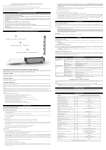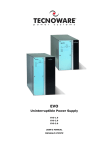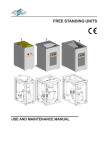Download EVO DSP MM 6-10K RM user`s manual ITA-ENG v. 1.7
Transcript
Uninterruptible Power Supply EVO DSP MM 6.0 Rack Mount EVO DSP MM 10.0 Rack Mount User’s manual Manuale utente Index User’s Manual - English ........................................................................ 1 Safety Warnings ................................................................................. 1 1 Introduction ................................................................................. 2 2 General Characteristics ................................................................... 3 3 Receipt and site selection ................................................................ 3 4 Operating Modes ........................................................................... 4 4.1 4.2 4.3 4.4 4.5 NORMAL Mode ......................................................................... BATTERY Mode ........................................................................ BYPASS Mode .......................................................................... ECO Mode .............................................................................. CONVERTER FREQUENCY Mode ...................................................... 5 5 5 6 6 5 EXTERNAL DESCRIPTION .................................................................. 7 5.1 Front Panel ............................................................................ 7 5.1.1 5.1.2 5.1.3 5.1.4 5.2 Graphic LCD Panel......................................................................... 8 Buttons.................................................................................... 10 LED Indicators............................................................................ 10 Acoustic Alarm ........................................................................... 11 Rear Side .............................................................................. 12 5.2.1 5.2.2 Input/Output Terminals ................................................................ 13 EPO (Emergency Power Off) ........................................................... 13 6 Electrical Installation ..................................................................... 14 6.1 Installation ............................................................................ 15 7 First Start Up ............................................................................... 16 8 Functioning ................................................................................. 17 8.1 8.2 8.3 8.4 8.5 8.6 8.7 Turning ON and OFF ................................................................. 17 Low Battery and Automatic Restart ............................................... 18 Load Testing .......................................................................... 18 External Manual Bypass ............................................................. 19 Battery Test .......................................................................... 19 Operation in Warning Status ....................................................... 20 Operation in Fault Mode ............................................................ 20 9 Communication Interfaces ............................................................... 21 10 Technical Characteristics ................................................................ 22 11 Maintenance................................................................................ 23 11.1 UPS Cleaning ......................................................................... 23 11.2 Battery ................................................................................ 24 11.3 Operator Safety ...................................................................... 24 12 Troubleshooting ........................................................................... 25 Conformity to the European Directives ................................................... 27 Product Disposal ............................................................................... 27 Lead Batteries ................................................................................. 27 Indice Manuale Utente – Italiano ................................................................... 29 Avvisi di Sicurezza............................................................................ 29 1 Introduzione ............................................................................... 30 2 Caratteristiche Generali................................................................. 31 3 Ricevimento e Collocazione ............................................................ 31 4 Modi di Funzionamento ................................................................. 32 4.1 4.2 4.3 4.4 4.5 Modo Modo Modo Modo Modo NORMALE ....................................................................... 33 BATTERIA ....................................................................... 33 BYPASS.......................................................................... 33 ECO ............................................................................. 34 CONVERTITORE di FREQUENZA .............................................. 34 5 Descrizione Esterna ...................................................................... 35 5.1 Pannello Frontale .................................................................... 35 5.1.1 5.1.2 5.1.3 5.1.4 5.2 Pannello LCD Grafico .................................................................... 36 Pulsanti .................................................................................... 38 Indicazioni a Led ......................................................................... 38 Allarme Acustico ......................................................................... 39 Pannello Posteriore .................................................................. 40 5.2.1 5.2.2 Morsettiera d’Ingresso/Uscita .......................................................... 41 EPO (Emergency Power OFF) ........................................................... 41 6 Installazione Elettrica ................................................................... 42 6.1 Installazione .......................................................................... 43 7 Prima Accensione......................................................................... 44 8 Funzionamento ........................................................................... 45 8.1 8.2 8.3 8.4 8.5 8.6 8.7 Accensione e Spegnimento ......................................................... 45 Fine Autonomia e Riaccensione Automatica...................................... 46 Controllo del Carico ................................................................. 46 Bypass Manuale Esterno ............................................................. 47 Test Batteria .......................................................................... 47 Segnalazioni di Allarme ............................................................. 48 Segnalazioni di Guasto .............................................................. 48 9 Interfacce di Comunicazione ........................................................... 49 10 Caratteristiche Tecniche ................................................................ 50 11 Manutenzione ............................................................................. 51 11.1 Pulizia dell’UPS ...................................................................... 51 11.2 Batterie................................................................................ 52 11.3 Sicurezza dell’Operatore ........................................................... 52 12 Anomalie ed Interventi .................................................................. 53 Conformità alle Direttive Europee ........................................................ 55 Smaltimento del Prodotto ................................................................... 55 Batterie al Piombo............................................................................ 55 ENGLISH User’s Manual - English Safety Warnings Read this manual carefully and completely before installing and using the TECNOWARE EVO DSP MM Uninterruptible Power Supply, which, from here after, will also be referred to as UPS. This manual should be kept close to the UPS and read before the UPS is installed and used. The UPS must be used only by properly trained personnel. To ensure correct and safe operations, it is necessary that operators and maintenance personnel observe the general safety Standards as well as the specific instructions included in this manual. Risk of electric shock: do not remove the cover. The UPS contains internal parts which are at a high Voltage and are potentially dangerous, capable of causing injury or death by electric shock. The electric installation has to be done by qualified personnel. Follow all the Safety Standards (CEI Standards in Italy or IEEE elsewhere) for the Input/Output connections and for the right section of Input/Output cables. There are no internal parts in the UPS which are user serviceable. Any repair or maintenance work must be performed exclusively by qualified technical personnel authorized by TECNOWARE. TECNOWARE declines any responsibility if this warning is disregarded. Warning to the technical personnel authorized for Service: since internal components are connected to the batteries, they will remain powered, and therefore dangerous, even after the UPS has been disconnected from AC power mains. Before any repair or maintenance work to the UPS unit, turn off the Battery circuit breaker on the rear side of Battery Box unit and then disconnect the Battery cable. CAUTION - HIGH BATTERY VOLTAGE AND RISK OF ELECTRIC SHOCK - the battery pack nominal voltage is 240 Vdc (there are 20 batteries series-connected inside the Battery Box unit). It is compulsory to ground the UPS according to Safety Standards. Risk of electric shock at the Output lines when the UPS is ON. Risk of electric shock at the Output lines while the unit is connected to the AC utility line. We recommend to use a dedicate AC Input/Output power line for the UPS. Do not obstruct ventilation slots or holes and do not rest any object on top of the UPS. Do not insert objects or pour liquids in the ventilation holes. Install the UPS indoors, in a protected, clean and moisture-free environment. Do not expose to the direct sun light. Do not keep liquids, flammable gases or corrosive substances near the UPS. UPS EVO DSP MM RM 1 User’s manual ENGLISH 1 Introduction UPS EVO DSP MM RM (UPS means Uninterruptible Power Supply) is the result of constant technological research aimed at obtaining the best performance at the lowest cost. UPS EVO DSP MM RM is an advanced ON-LINE UPS built specifically to protect your computer from any irregularities in the AC line (for example blackouts, brownouts, over voltages, micro-interruptions) which often cause damage to hardware and software. All that is possible because UPS EVO DSP RM is a Double-Conversion ON-LINE UPS. Under normal AC line condition UPS EVO DSP MM RM provides an automatic Output Voltage regulation from the Rectifier and Inverter blocks and filters out frequently occurring electrical disturbances (high Voltage transients, spikes, interferences, etc.), thus protecting the devices connected to its outlets. During a power failure, UPS EVO DSP MM RM continues supplying adequate AC power (with a true sine wave) to all connected devices through its internal batteries and by its DC/AC converter (Inverter). UPS EVO DSP MM RM protects the devices from accidental overload or Inverter fault by an Automatic Bypass that directly connects the AC Input line with its outlets. The EVO DSP MM RM models are factory-equipped with RS-232 and USB interfaces, which may be used for notify to a computer a power failure or a Low Battery condition: this allows automatic data backup during an extended blackout with the most common operating systems (Windows, Linux, Unix, etc). Thanks to Interfaces, UPS DSP MM RM can communicate the several made measurements (Input/Output Voltage, batteries, absorption, Frequency, etc.), and can also be programmed in order to start-up or shutdown automatically at fixed times. This manual is a guide that enables you to correctly install and use your UPS. This manual includes important SAFETY instructions for the operator, for the UPS correct installation, and gives useful advice on the product and battery maintenance. For any type of problem, please refer to this manual before calling the customer service. EVO DSP MM RM is constantly being developed and improved: consequently, your unit may differ somewhat from the description contained in this manual. This manual includes the following models: • EVO DSP MM 6.0 RM (6 KVA) • EVO DSP MM 10.0 RM (10 KVA) In this manual EVO DSP MM RM will simply be referred to as UPS. EVO DSP MM RM models are made of 2 separate units: the UPS unit (containing the control and power electronics) and the Battery Box unit containing the batteries and batteries charger. The 2 units must be connected together as explained into chapter 6 “Electrical Installation” All models can be placed in 19” rack cabinets. Optional accessory kits are available for the installation in rack cabinets. Each unit (UPS unit or Battery Box unit) has a 3U height (1U is equal to 1 Rack unity, about 44,5 millimetres). User’s manual 2 UPS EVO DSP MM RM ENGLISH 2 General Characteristics UPS EVO DSP MM RM has all the advanced features which guarantee maximum reliability and safety: • Double-Conversion ON-LINE Transformerless technology • Sinusoidal wave generated by an IGBT Inverter • Output Voltage regulation ±1% • Protection from overload and short circuits • Automatic Bypass to protect from accidental overload or Inverter fault • Automatic protection when Battery is low • Automatic restart, following an automatic shut-down due to Low Battery, once AC utility power comes back on • Selectable Input Frequency (50/60 Hz) • Graphic LCD panel for visualization of the Input and Output Voltage measurements, batteries Voltage, percentage of load, Frequency, alarms, overload, fault and path of energy flow • Acoustic signals of various kinds indicating alarm situations • Available settings of all the UPS parameters by user through front panel pushbuttons and graphic LCD panel • SNMP Adapter (optional) • EPO (Emergency Power OFF) • Communication with the computer through RS-232 and USB interfaces • Available extended autonomy by adding external Battery Boxes • ECO functioning mode (selectable) • Frequency Converter functioning mode (selectable) • High efficiency • Maximum reliability • Can be fitted in a 19” rack cabinet through optional kits • Smart design and easy to use 3 Receipt and site selection Carefully remove the UPS from its packaging, and carry out a meticulous inspection. We recommend keeping the original packaging in a secure place, in case you need to send the UPS for maintenance purposes. In case of transport damage, notify the carrier and dealer immediately. We recommend paying attention to the below points in order to choose a correct placement for your UPS: • The UPS is designed to operate in a protected environment (e.g. offices). We therefore recommend installing it in a place with very little or no humidity, dust or smoke. • When the UPS is brought from a cold place to a warmer place, humidity in the air may cause condensation in the UPS. In this case, allow UPS to stand for two hours in the warmer place before beginning with the installation. UPS EVO DSP MM RM 3 User’s manual ENGLISH • In all circumstances, see the “Technical Characteristics” chapter for environmental specifications and check that the selected area meets these criteria. • During normal operation the UPS discharges a minimal amount of heat. So it is necessary to leave at least 10 cm of unobstructed space all around the UPS in order to keep it properly ventilated. • Do not obstruct ventilation holes. • Do not insert objects or pour liquids in the ventilation holes. • Do not rest any object on top of the UPS. • Do not keep liquids, flammable gases or corrosive substances near the unit. • Install the UPS on a properly tiled floor. Avoid the installation on a floor that is not tiled flat. 4 Operating Modes NORMAL MODE BATTERY MODE BYPASS MODE Figure 1 – Operating modes User’s manual 4 UPS EVO DSP MM RM ENGLISH 4.1 NORMAL Mode The UPS typically works in Normal mode: Input mains power is available and its amplitude is within specifications. Please refer to figure 1. After the filter has eliminated any high Frequency interference present on the mains, the AC Input line is rectified and conditioned in the Rectifier block (AC/DC conversion); the continuous power now enters into the Inverter block and is then reconverted into alternated power (DC/AC conversion), overcoming the Automatic Bypass and feeding the load after an extra filtration. At the same time the UPS recharges the batteries through the Battery Charger block. Please refer to figure 2, which describe the UPS front panel. The Normal mode is identified by: • Line led is ON. • The graphic LCD panel shows the path of energy flow during Normal mode. 4.2 BATTERY Mode During operation in Normal mode, if the UPS finds the Mains OFF condition (due to a Blackout or Overvoltage/Brownout), it then switches into Battery mode. In this case, the batteries supply the required Output power thanks to the DC/AC conversion carried out by the Inverter. The UPS switches back to Normal mode a few seconds after AC Input power is restored or Voltage comes back to internal specifications. Please refer to figure 1. The Battery mode is identified by: • Battery led is ON. • The graphic LCD panel shows the path of energy flow during Battery mode. • An acoustic signal every 4 seconds. 4.3 BYPASS Mode In Bypass mode, the AC Input line is directly connected with the UPS outlets by an Automatic Bypass. As indicated in figure 1, in Bypass mode the UPS recharges the batteries. If you connect the AC Input line to the UPS and the Input line breaker on the rear is “ON”, the UPS will go to Bypass mode. The Bypass mode is an idle mode for the UPS: then by pressing ON button, the UPS turns ON completely, activating the Inverter block. When the UPS works in Bypass mode it can be considered as “not active”, since the Inverter block is not active. The UPS is considered “active” when the Inverter block is ON (in Normal mode and in Battery mode). Furthermore the UPS switches automatically to Bypass mode as a consequence of accidental overload or Inverter fault thus protecting the supplied devices. UPS EVO DSP MM RM 5 User’s manual ENGLISH The Bypass mode is identified by: • Bypass led is ON. • The graphic LCD panel shows the path of energy flow during Bypass mode. • An acoustic signal every 2 minutes. During Bypass mode, loads are fed directly from AC Input line. Therefore no protection against AC Input line disturbances or interruptions is present. 4.4 ECO Mode It is possible to select the ECO mode to save energy and to increase the efficiency of the UPS. The ECO mode uses the Bypass to feed the loads. The UPS will operate as in Bypass mode whenever the Frequency/waveform/RMS value of AC Input line mains Voltage is within their tolerance limits. If the AC Input line Voltage goes beyond these limits, the UPS switches into normal operation. Please contact Technical Service for the instruction to enable the ECO mode; by default ECO mode is disable. ECO mode does not provide perfect stability in Frequency/waveform/RMS value of the Output Voltage like in Normal mode. Thus, the use of this mode should be carefully executed according to the level of protection required by the application. The ECO mode is identified by: • Bypass and Line leds are ON. • The graphic LCD panel shows the path of energy flow during ECO mode (the “ECO” icon is ON). 4.5 CONVERTER FREQUENCY Mode It is possible to select the Converter Frequency mode to work with the Output Frequency different from the Input Frequency. For example it is possible to work with 60 Hz Input Frequency and 50 Hz Output Frequency or 50Hz Input Frequency and 60 Hz Output Frequency. Please contact Technical Service for the instruction to enable the Converter Frequency mode; by default Converter Frequency mode is disable, and the Output Frequency will synchronize automatically with the Input Frequency. The Converter Frequency mode is identified by: • Line led is on. • The graphic LCD panel shows the path of energy flow during Bypass mode. • The “CF” characters are ON. User’s manual 6 UPS EVO DSP MM RM ENGLISH 5 EXTERNAL DESCRIPTION 5.1 Front Panel The front panel informs the user about operating status, alarm conditions and measurements. It also provides access to controls and configuration parameters. Front panel shown below consists of three parts: 1. Graphic LCD panel provides complete information about the energy flow path and existing alarms, Load and Battery level, Input, Output and Battery measurements. 2. 4 LED’s when illuminated indicate UPS status. 3. 4 buttons enables the user to turn ON/OFF the UPS and to make selections of the functioning parameters. Bypass Line Battery Fault OFF TEST MUTE ON Figure 2 – Front panel UPS EVO DSP MM RM 7 User’s manual ENGLISH 5.1.1 Graphic LCD Panel Please refer to figure 3. Input & Battery Voltage Info Backup Time Info Fault Info Buzzer Info Battery Info Output Voltage Info Load Info Mode Operation Info Programmable Output Info Figure 3 – Graphic LCD Panel Graphic LCD Panel Function Backup time information Indicates how much time has passed in Battery mode. H: hours, M: minutes, S: seconds Fault information Indicates the warning that a fault has occurred. Indicates the Fault codes, and the codes are listed in the “Fault Table” of chapter 8. Mute operation Indicates that the UPS alarm is disabled (muted). Output Voltage information Indicates the Output Voltage or Frequency. Vac: Output Voltage, Hz: Output Frequency User’s manual 8 UPS EVO DSP MM RM ENGLISH Graphic LCD Panel Function Load information Indicates the load level by 0-25%, 26-50%, 51-75%, and 76-100%. Indicates Overload. Indicates the load or the Output is short-circuited Programmable Output information Indicates that there is an active scheduling for the programmable Output. Mode operation information Indicates the UPS connects to the mains. Indicates the Battery is working. Indicates the Bypass circuit is working. Indicates the ECO mode is enabled. Indicates the Inverter circuit is working. Indicates the Output is working. Battery information Indicates the Battery capacity by 0-25%, 26-50%, 51-75%, and 76-100%. Indicates the Battery is faulty or defective. Indicates Low Battery level and Low Battery Voltage. Input and Battery Voltage information Indicates the Input Voltage or Frequency or Battery Voltage. Vac: Input Voltage, Vdc: Battery Voltage, Hz: Input Frequency UPS EVO DSP MM RM 9 User’s manual ENGLISH 5.1.2 Buttons Functions of the buttons are given below: Button Function ON Turn ON: press and hold the button more than 0.5 sec to turn the UPS ON. OFF Turn OFF: press and hold the button more than 0.5 sec to turn the UPS OFF. TEST Battery Test: press and hold the button more than 0.5 sec to test the Battery while in Normal mode. MUTE Mute the alarm: press and hold the button more than 0.5 sec to mute the buzzer. If you press it again after the buzzer is muted, the buzzer will beep again. 5.1.3 LED Indicators There are 4 LED’s on the front panel to show the UPS working status: Status Bypass Line Battery Fault UPS Start Up ● ● ● ● Bypass Mode ● ○ ○ ○ Normal Mode ○ ● ○ ○ Battery Mode ○ ○ ● ○ Frequency Converter Mode ○ ● ○ ○ Battery Test ● ● ● ○ ECO Mode ● ● ○ ○ Fault Mode ○ ○ ○ ● Note: LED ● means LED is lit (ON) and ○ means LED is not lit (OFF). User’s manual 10 UPS EVO DSP MM RM ENGLISH 5.1.4 Acoustic Alarm Description Buzzer Status OFF UPS status Bypass Mode Beeping once every 2 minutes Battery Mode Beeping once every 4 seconds Fault Mode Beeping continuously YES Warning Overload Beeping twice every second Low Battery Battery Unconnected Over Charge EPO condition Fan failure/Over Temperature Beeping once every second NO Charger failure Input Circuit failure Overload (3 times in 30 min) Fault Vdc Bus Start failure Vdc Bus Over Vdc Bus under Vdc Bus Unbalance Vdc Bus short-circuit Inverter Soft Start failure High Inverter Voltage Low Inverter Voltage Inverter Output short-circuit Power Fault Beeping continuously YES Battery SCR short-circuit Inverter short-circuit Battery Voltage Loss Parallel Communication failure Output short-circuit Over Temperature CPU Communication failure Overload Note: OFF = YES means that the buzzer can be muted or stopped OFF = NO means that the buzzer can NOT be muted or stopped UPS EVO DSP MM RM 11 User’s manual ENGLISH 5.2 Rear Side Figure 4 – above: UPS unit; below: BATTERY BOX unit 1. Computer Interface (DB9 female connector): it is the communication RS-232 port. 2. Computer Interface (USB connector): it is the communication USB port. 3. EPO (Emergency Power OFF) connector 4. Output fuse breaker: for Output receptacle IEC type (#7); 10A max current. 5. Input circuit breaker 6. Slot for SNMP Interface (optional) 7. Output receptacle (IEC C13 type): to supply small critical loads. 8. Metallic panel for access to the Input/Output terminals: upon removal, it is possible to access the Input/Output terminals (see figure 5). 9. Metallic cover of Battery connector (UPS unit): remove the metal cover to access to the Battery connector and to connect the UPS unit to the Battery Box unit by the included Battery cable. 10. Charger and Power stage fans 11. External Manual Bypass terminals (EMBS) 12. Battery circuit breaker: to cut Battery voltage from UPS unit. 13. Grounded AC Input power socket, for recharging batteries: (IEC C14 type); only connecting this socket to an AC Input line by the included power cable, it is possible to recharge the batteries inside the box. 14. Input fuse breaker: for Input socket (#14); 10A max current. 15. Metallic cover of Battery connector (Battery Box unit): remove the metal cover to access to the Battery Connector and to connect the Battery Box unit to the UPS unit, or to connect the Battery Box unit to a further Battery Box unit. 16. As point 15. User’s manual 12 UPS EVO DSP MM RM ENGLISH 5.2.1 Input/Output Terminals Figure 5 – Input/Output Terminals INPUT terminals: to connect AC Input line. OUTPUT terminals: to connect OUTPUT line. GROUND terminal: to connect INPUT and OUTPUT GROUND cables. 5.2.2 EPO (Emergency Power Off) EVO DSP MM RM models have the EPO (Emergency Power OFF) connector on the rear side, (see figure 6). This permits to immediately switch the UPS Output OFF from a distance in case of emergency. The UPS is supplied with EPO short-circuited terminals and in this case the product works normally. If you want to use an external switch to turn OFF the UPS by EPO, then remove the short-circuit from the EPO terminals and connect the switch to the EPO terminals as described in the figure 6. EPO 2 1 REMOTE EPO SWITCH Figure 6 – EPO (Emergency Power OFF) If the switch is CLOSED the UPS works normally; if, on the contrary, the switch becomes OPEN then the UPS Output turns OFF immediately. To switch the UPS Output ON again after an EPO, it is necessary to close again the EPO switch. The EPO terminals do not need an external feeding Voltage and are isolated from the dangerous voltages that are present inside the UPS. UPS EVO DSP MM RM 13 User’s manual ENGLISH 6 Electrical Installation The electrical installation has to be done by qualified personnel. Follow all the Safety Standards (CEI Standards in Italy or IEEE elsewhere) for the Input/Output connections and for the right selection of Input/Output cables. We recommend to use dedicate AC Input/Output power lines for the UPS. For safety we recommend using external circuit breakers between Input mains and UPS AC Input line and between UPS Output lines and the loads. The circuit breakers should be qualified with leakage current protective function (leakage current < 30 mA). EVO DSP MM RM models are made of 2 separate units: the UPS unit (containing the control and power electronics) and the Battery Box unit containing the batteries and the batteries charger. Before starting the installation procedure, be sure that: 1. The Input circuit breaker of UPS unit is “OFF” (see figure 4). 2. The Battery circuit breaker of Battery Box unit is “OFF” (see figure 4). 3. The AC Input Voltage for the UPS has been removed. 4. The UPS is completely OFF (only if graphic LCD panel is OFF). The following table shows the recommended size for Input, Output and Battery wires. Wiring spec (cross section) Model Input Output Battery Ground EVO DSP MM 6.0 RM 4 mm2 4 mm2 4 mm2 4 mm2 EVO DSP MM 10.0 RM 6 mm2 6 mm2 6 mm2 6 mm2 The cables for EVO DSP MM 6.0 RM should be able to withstand until 40A current. It is recommended to use 4 mm2 or thicker wire for safety and efficiency. The cables for EVO DSP MM 10.0 RM should be able to withstand until 63A current. It is recommended to use 6 mm2 or thicker wire for safety and efficiency. We recommend using only flexible TRI-RATED cables. Otherwise if you use rigid cables, it will be difficult to move the UPS from initial positioning. We recommend to use dedicate AC Input/Output power Lines for the UPS. User’s manual 14 UPS EVO DSP MM RM ENGLISH 6.1 Installation Connect the GROUND wire first when making wire connection. Disconnect the GROUND wire last when making wire disconnection. Make sure that the wires are connected tightly to the terminals. We advise you to follow the steps below explained: 1. Remove the metallic panel that covers the Input/Output terminals, see figure 4. The terminals are shown in figure 5. All the cables have to reach the terminals from the rear side using the proper holes in the metallic panel. 2. Connect the INPUT line (LINE, NEUTRAL and GROUND), paying attention to the right polarity, in accordance with figure 5, as explained below: Connect INPUT GROUND wire to the GROUND terminal. Connect INPUT LINE wire to the INPUT L terminal. Connect INPUT NEUTRAL wire to the INPUT N terminal. 3. Connect the OUTPUT line (LINE, NEUTRAL and GROUND) as follow: Connect OUTPUT GROUND wire to the GROUND terminal. Connect OUTPUT LINE wire to the OUTPUT L terminal. Connect OUTPUT NEUTRAL wire to the OUTPUT N terminal. 4. Reassemble the metallic panel that gives access to the UPS terminals. The instructions below describe the operations to correctly connect the UPS unit to the Battery Box unit. ATTENTION: the UPS unit doesn’t work without Battery Box unit because the batteries are inside the Battery Box unit. We suggest to use ONLY Battery Box unit supplied by TECNOWARE. TECNOWARE declines any responsibilities if this rule is not followed. 5. Proceed with the connection of Battery Box unit through the following operations: Remove the metallic cover of Battery connector on the UPS unit (# 9 figure 4) Remove the metallic cover of Battery connector on the Battery Box unit (# 15 or #16, figure 4) Connect the Battery connectors of UPS unit and Battery Box unit by the included Battery cable. Screw the GROUND terminal of Battery cable on the case of UPS unit by using a screw of metallic cover. Screw the GROUND terminal of Battery cable on the case of Battery Box unit by using a screw of metallic cover. Connect the AC Input power socket of the Battery Box unit (# 13 figure 4) to an AC utility line for recharging batteries. CAUTION - HIGH BATTERY VOLTAGE AND RISK OF ELECTRIC SHOCK - the battery pack nominal voltage is 240 Vdc (there are 20 batteries series-connected inside the UPS. 6. Restore the AC Input mains Voltage to the UPS. UPS EVO DSP MM RM 15 User’s manual ENGLISH It is compulsory to ground the UPS according to the Safety Standards. The case of the UPS is internally connected to the ground terminal (GND) of the IN/OUT terminals, in order to guarantee safety to the user. To guarantee safety it is necessary to be sure that the local electric plant is supplied with GROUND (in compliance with the Safety Standards), and that a valid connection is guaranteed between the GROUND of the UPS and the GROUND of the local electric plant. Any interruption of the GROUND conductor is absolutely prohibited. We recommend to use dedicate AC Input/Output power Lines for the UPS. Risk of electric shock at the Output lines if the UPS is ON, even when the UPS is not connected to AC utility line. Risk of electric shock at the Output lines while the unit is connected to the AC utility line. Risk of electric shock: do not remove the cover. The UPS contains internal parts which are at a high Voltage and are potentially dangerous, capable of causing injury or death by electric shock. There are no internal parts in the UPS which are user serviceable. Any repair or maintenance work must be performed exclusively by qualified technical personnel authorized by TECNOWARE. TECNOWARE declines any responsibility if this warning is disregarded. Disregard for these warnings may lead to a risk of electric shock to operators. 7 First Start Up Turning the UPS ON is very easy. Nevertheless we recommend that, on First Start Up, the following procedure is observed for greater safety. 1. Turn “ON” the Battery circuit breaker of the Battery Box unit (see figure 4). 2. Check if the Input circuit breaker the rear side of UPS unit is in “OFF” position (see figure 4). 3. Check that no load is connected to the UPS Outputs. 4. Check that the AC Input Voltage is within Input specifications. 5. Turn “ON” the Input circuit breaker. All the led’s are on for some seconds; in the same time the UPS performs a functioning SELF-TEST. Then the UPS starts to work in Bypass mode: the Bypass led is ON and the graphic LCD panel shows the path of energy during Bypass mode. 6. Press the ON button on front panel until the UPS emits an acoustic signal: after approximately 4 seconds the Inverter turns ON and the UPS starts to work in Normal mode: the Line led will be ON, the Bypass led will be OFF and the graphic LCD panel will show the path of energy during Normal mode. 7. Simulate a black-out by removing the AC Input. The UPS starts working in Battery mode: the Battery led will be on, the Line led will be off and the graphic LCD panel will show the path of energy during Battery mode. Moreover UPS emits a brief acoustic signal every 4 seconds. When Battery level is ending the acoustic signal will be emitted every 1 second. 8. Restore the AC Input: after few seconds the UPS turns back in Normal mode. 9. The UPS has passed first start up check: now connect the loads to be supplied to the UPS Output and turn them ON, checking UPS doesn’t report Overload information on the graphic LCD panel. By LCD display check if the Output load percentage is less than 100%; otherwise it is necessary to remove part of the loads at the Output lines. User’s manual 16 UPS EVO DSP MM RM ENGLISH Before using the UPS normally, leave it in Normal mode and feed the Battery Box for at least 10 hours in order to charge Battery completely (the UPS charges Battery also in Bypass mode). The batteries reach the 90% of their capacity after about 10 hours of recharge. 8 Functioning 8.1 Turning ON and OFF Let’s see carefully the consequences of the pressure of ON and OFF buttons. The UPS is in Bypass mode (the Inverter is OFF); if the ON button is pressed, after few seconds the Inverter starts and the UPS switches in Normal mode. The UPS is in Normal mode (the Inverter is ON); if the OFF button is pressed, the Inverter turns OFF and the UPS switches in Bypass mode. To turn completely OFF the UPS please do the following steps: Put the UPS in Bypass mode by pressing the OFF button Place the Battery circuit breaker of Battery Box unit in “OFF” position Place the Input circuit breaker in “OFF” position The graphic LCD panel and the leds on the front panel are OFF only when the UPS is completely OFF. If UPS is used daily, it is recommended to leave the Input circuit breaker always “ON” and use the ON and OFF buttons on the front panel to activate/deactivate the Inverter. If the UPS has to be turn OFF for several days, it is recommended to turn OFF the Input circuit breaker and to turn OFF the Battery circuit breaker of the Battery Box unit. If the ON button is pressed when AC Input is not present, the UPS switches ON even, and works in Battery mode after about 4 seconds. If the OFF button is pressed when AC Input is not present, then the Inverter switches OFF and consequently there will be no Output power. In Bypass mode, the Inverter is NOT ACTIVE and the UPS doesn’t work as an UPS, but only as a Bypass between Input and Output power lines. In Bypass mode, the UPS supplies the load only if AC Input is present. In Bypass mode the Output load isn’t protected in case of black-out. UPS EVO DSP MM RM 17 User’s manual ENGLISH 8.2 Low Battery and Automatic Restart The UPS reaches the Low Battery condition whenever, during working in Battery mode, the batteries reach a charge level allowing the connected devices to operate for few minutes more. The UPS warns operators of Low Battery by lighting of the LOW BATT. icon on the graphic LCD and by emitting an acoustic signal every second. If AC Input does not come back on within few minutes, the UPS shuts-down automatically thus preventing the batteries from discharging excessively; the UPS stops supplying Output power, deactivates control panel indication and goes to a waiting state. Once AC Input comes back on, the UPS restarts automatically and after 4 seconds it goes back to work in Normal mode. After a complete discharge, the UPS needs 10 hours to recharge completely the batteries. The UPS recharges batteries automatically if it works in Normal mode or in Bypass mode. 8.3 Load Testing The UPS indicates the Output Load level by graphic LCD (on the right side as described in the chapter 5). When the Output load is higher then nominal value the UPS warns of Overload condition by graphic LCD and by acoustic alarm as described in the “Warning Table” and in the “Troubleshooting” chapter. The UPS has the capability to accept an Overload less than 110% for 10 minutes. An Overload between 110% and 130% is accepted for about 1 minute and after UPS switches automatically to the Bypass mode. An Overload higher than 130% is accepted for 1 second and after the UPS switches automatically to the Bypass mode. Once the requested power is back within range, the UPS switches automatically to the Normal mode. Make sure that the UPS never indicates Overload condition. Do not connect a load greater than rated value to the UPS (see POWER specifications in the chapter “Technical Characteristics”), as this may damage the unit. In this case the warranty is void. User’s manual 18 UPS EVO DSP MM RM ENGLISH 8.4 External Manual Bypass External Manual Bypass (EMBS) terminals: the terminals are normally close. Use ONLY to connect at AUX switch of the external manual Bypass. The UPS works normally only if AUX switch is closed (ON); otherwise, if the AUX switch is open (OFF), the UPS works in Bypass mode. EXTERNAL MANUAL BYPASS SIGNAL (EMBS) EXTERNAL BYPASS AUX SWITCH Figure 7 – Connection EXTERNAL BYPASS to EMBS terminals 8.5 Battery Test If you need to check the Battery Status when the UPS is running in Normal mode/Converter Frequency mode/ECO mode, you could press the TEST button to let the UPS do the Battery Test. The Battery Test starts immediately and it finishes after some seconds. If the batteries pass the test, no alarm will be shown. During the Battery Test, the graphic LCD and buzzer indication will be the same as at Battery mode except that the Battery led is flashing. To keep the system reliable, the UPS will perform the Battery Test automatically once per week. User also can set Battery Test through monitoring software. UPS EVO DSP MM RM 19 User’s manual ENGLISH 8.6 Operation in Warning Status When Fault led flashes and the buzzer beeps once every second, it means that there are some problems for UPS operation. Users can get the Fault code from graphic LCD panel. Please check the “Troubleshooting” chapter for details. Below you can see the “Warning Table”, with the correspondence between each warning and the relative signals (icons on graphic LCD and acoustic alarm) for the user. Some acoustic alarms can’t be muted unless the error is fixed. Please refer to chapter 5 for the details. WARNING ICON (flashing) ACOUSTIC ALARM Low Battery Beeping every second Overload Beeping twice every second Battery Unconnected Beeping every second Over Charge Beeping every second EPO enable Beeping every second Fan failure/Over temperature Beeping every second Battery Charger failure Beeping every second Input Circuit failure Beeping every second Overload 3 times in 30 min Beeping every second Warning Table 8.7 Operation in Fault Mode When Fault led illuminates and the buzzer beeps continuously, it means that there is a fatal error in the UPS. Users can get the Fault code from display panel. Please check the “Troubleshooting” chapter for details. Please check the loads, wiring, ventilation, mains supply, Battery and so on after the fault occurs. Don’t try to turn ON the UPS again before solving the problems. If the problems can’t be fixed, please contact Technical Service immediately. In case of emergency, please immediately disconnect the UPS unit from mains supply, disconnect the Box Battery cable and the Output lines to avoid further risk or danger. Below you can see the “Fault Table”, with each Fault event and the relative FAULT code/icon on graphic LCD for the user’s information. User’s manual 20 UPS EVO DSP MM RM ENGLISH FAULT EVENT FAULT CODE ICON FAULT EVENT FAULT CODE ICON Vdc Bus Start failure 01 None Power fault 1A None Vdc Bus Over 02 None Battery SCR short-circuit 21 None Vdc Bus under 03 None Inverter short-circuit 24 None Vdc Bus Unbalance 04 None Battery Voltage Loss 28 Vdc Bus short-circuit 05 None Parallel Communication failure 35 None Inverter Soft Start failure 11 None Output short-circuit 36 None High Inverter Voltage 12 None Over Temperature 41 None Low Inverter Voltage 13 None CPU Communication failure 42 None Inverter Output short-circuit 14 Overload 43 Fault Table 9 Communication Interfaces The UPS is factory-equipped with RS232 and USB Communication Interfaces. On the UPS rear side there are the connections of the Interfaces. Only one of the RS232/USB communications can be activated at one time. To activate RS232 communication it is sufficient to connect the RS232 cable only; to activate USB communication it is sufficient to connect the USB cable only. The RS-232 and USB signals are all isolated through photo-couplers from the dangerous voltages that are present inside the UPS. It is possible to use a SNMP (Single Network Management Protocol) Interface to connect the UPS to a LAN (Local Area Network). The SNMP interface is optional. We advise you to follow the steps below explained to install the interface correctly: 1. Remove the metallic panel (#6, figure 4) that covers the slot for SNMP interface. 2. Put the SNMP Interface into the slot and fix it with screws. 3. Connect the LAN cable to SNMP interface and follow the included instruction to make the interface working well. UPS EVO DSP MM RM 21 User’s manual ENGLISH 10 Technical Characteristics UPS EVO DSP MM Rack Mount Model Power Nominal Active Power 6.0 10.0 6000 VA 10000 VA 4800 W 8000 W Power Factor 0.8 Technology On-Line Double Conversion Transformerless Dimension (W x H x D) - UPS unit 43.8 x 13.3 x 58 cm 43.8 x 13.3 x 66.8 cm 43.8 x 13.3 x 66.8 cm 43.8 x 13.3 x 66.8 cm Net Weight - UPS unit 17 kg 20 kg Net Weight - Battery Box unit 57 kg 65 Kg Dimension (W x H x D) – Battery Box unit INPUT Nominal Voltage Single Phase 208/220/230/240 Vac Voltage Range for Normal mode 110 Vac ± 3% (at 50% Load) Lower Limit 176 Vac ± 3% (at 100% Load) Upper Limit 300 Vac ± 3% Nominal Frequency 50/60 Hz (selectable) Frequency Range (Normal mode) ± 7% Input Power Factor 0.99 (at 100% Load) OUTPUT Nominal Voltage Single Phase 208/220/230/240 Vac (selectable) Voltage Regulation ±1% Inverter Waveform True Sinewave Nominal Frequency 50/60 Hz (selectable) Free Running Frequency (Battery mode) (50 Hz ± 0.1%) or (60 Hz ± 0.1%) Total Harmonic Distortion (THD) < 3% (100% Linear Load); < 6% (100% Non-Linear Load) Crest Factor 3:1 max Overload (Normal mode) (100÷110)% for 10 min; (110÷130)% for 1 min; > 130% 1 sec Overload (Battery mode) (100÷110)% for 30 sec; (110÷130)% for 10 sec; > 130% 1 sec Transfer Time (Normal <--> Battery) 0 ms (Battery <--> Bypass) 0 ms (Normal <--> Eco) Efficiency < 10 ms > 89% (Normal mode); > 88% (Battery mode); > 98% (ECO mode) BATTERIES (In External Battery Box gettable separately) Battery Type Lead acid, sealed, free maintenance Number of batteries 20 Nominal Battery Voltage 240 Vdc Battery Charge Time (typical) 8 hours Expandable Autonomy User’s manual Available, through external Battery Box (optional) 22 UPS EVO DSP MM RM ENGLISH ENVIRONMENTAL CONDITIONS Storage Temperature Range Operating Temperature Range -15°C to +40°C (15°C to 25°C recommended for longer Battery life) 0°C to +40°C (20°C to 25°C recommended for longer Battery life) Relative Humidity Range 0% - 95% (non condensing) Max. Altitude without Derating 3000 m Protection level IP 20 Cooling Fan cooling Audible Noise (at 1 meter) < 55 dBA < 58 dBA STANDARDS Safety CEI EN 62040-1: 2009 Performance CEI EN 62040-3: 2009 EMC CEI EN 62040-2: 2006 category C3 Product certification CE COMMUNICATIONS Computer Interface Software 1 RS232 port and 1 USB port Included software UPSilon 2000 compatible with: Windows, Linux, Novell SNMP Interface Optional OTHERS EPO (Emergency Power OFF) Included External Bypass Contact Included ECO Mode Selectable Frequency Converter Mode Selectable Technical data may change without prior notice 11 Maintenance 11.1 UPS Cleaning Before starting any cleaning operation, be sure that: 1. The Input circuit breaker of UPS unit is “OFF” (see figure 4). 2. The Battery circuit breaker of Battery Box unit is “OFF” (see figure 4). 3. The AC Input Voltage for the UPS has been removed. 4. The UPS is completely OFF (only if graphic LCD panel is OFF). Use only a cloth dampened with water to clean the unit. If UPS works in an environmental unusually dusty or dirty, remove the dirty from the ventilation holes. Before restarting the UPS be sure it is completely dry. If any liquid gets inside the UPS, do not start the unit and contact Technical Service immediately. UPS EVO DSP MM RM 23 User’s manual ENGLISH 11.2 Battery If the UPS is NOT going to be used for a long period of time, ensure that the batteries are left fully charged. If the UPS has not been used for more than three months, go through the procedure described in the chapter 7 “First Start Up” before using it again. Please keep in mind that the batteries must be recharged at least once a month. Take in mind that batteries are recharged automatically (if the UPS is ON and working in Normal or in Bypass mode) for after approximately 10 hours with AC Input line present. Battery life strongly depends on the ambient temperature. There are also other factors like the number of chargedischarge cycles, the discharge depth, humidity and altitude. The recommended environmental specifications for a correct use of batteries are listed in the “Technical Specifications” section. Performing Battery Test can provide you with information about Battery condition (see “Battery Test” section for more information on Battery Test). Battery replacement must be performed exclusively by qualified technical personnel authorized by TECNOWARE. TECNOWARE declines any responsibility if this warning is disregarded. When replacing batteries, replace with the same type and number. To remove the batteries, firstly you have to turn off the UPS unit and disconnect the AC Input Line, then turn off the Battery circuit breaker of the Battery Box unit, disconnect the Battery cable and disconnect the Input cable for recharging batteries. Then remove the front panel of the Battery Box unit; behind front panel there is a metal plate: remove it. So you can access to 5 battery strings (each string has four batteries): disconnect each string and take out the battery strings. Then disconnect batteries one to each other and take them off from their housing one by one. CAUTION - A battery can present a risk of electrical shock and high short circuit current. The following precautions should be observed when working on batteries: a) Remove watches, rings or other metal objects; b) Use tools with insulated handles; c) Wear rubber gloves and boots; d) Do not lay tools or metal parts on top of batteries; e) Disconnect the charging source prior to connecting or disconnecting battery terminals; f) Determine if battery is inadvertently grounded. If inadvertently grounded, remove source from ground. CAUTION - Do not dispose of batteries in a fire. The batteries may explode. CAUTION - Do not open or mutilate batteries. Released electrolyte is harmful to the skin and eyes. It may be toxic. 11.3 Operator Safety Whenever the UPS is not responding anymore to original characteristics, the UPS must be made non-operative and every usage not authorised must be avoided. After it will be necessary to refer to qualified technical personnel. Original safety characteristics might not be if, for example, the UPS has visible damage or irregular operation. User’s manual 24 UPS EVO DSP MM RM ENGLISH 12 Troubleshooting This section gives information about the procedures which shall be performed in case of abnormal operation. If you fail to fix the problem consult authorized Technical Service with the following information: Model and serial number of the UPS, which can be found on the nameplate on the rear of the UPS. Description of abnormal operation and Fault code displayed on graphic LCD. If you have noticed an abnormality in operation; check the Protective Ground/Earth connections, examine the circuit breakers positions, read alarms code from the graphic LCD and refer to the table below. Apply all suggestions corresponding to each anomaly. If your issue is excluded or the suggested actions do not solve your problem, consult the Technical Service. Risk of electric shock: do not remove the cover. The UPS contains internal parts which are at a high Voltage and are potentially dangerous, capable of causing injury or death by electric shock. There are no internal parts in the UPS which are user serviceable. Any repair or maintenance work must be performed exclusively by qualified technical personnel authorized by TECNOWARE. TECNOWARE declines any responsibility if this warning is disregarded. Warning to the technical personnel authorized for service: since internal components are connected to the batteries, they will remain powered, and therefore dangerous, even after the UPS has been disconnected from AC power mains. Before any repair or maintenance work to the UPS unit, turn off the Battery circuit breaker on the rear side of Battery Box unit and then disconnect the Battery cable. SYMPTOM POSSIBLE CAUSE No indication and/or alarm on the front panel even though the main is normal. The graphic LCD is OFF. The AC Input line cable is not connected well. The icon The icon and flash on LCD display and alarm beeps every second. Check if Input cable is firmly connected to the Input mains. The Input circuit breaker is “OFF”. Check the Input circuit breaker: if it is “OFF” please switch it “ON”. EPO function is enabled. Set the EPO circuit in closed position to disable EPO function. The external or internal batteries are incorrectly connected. Check if all batteries are connected correctly. Battery Voltage is too Low or the Battery Charger is faulty. Contact Technical Service. and the warning code flash on LCD display and alarm beeps every second. ACTION TO SOLVE Fault code is shown as 28, the icon lights on LCD display, and alarm beeps continuously. UPS EVO DSP MM RM 25 User’s manual ENGLISH SYMPTOM The icon and flash on LCD display and alarm beeps twice every second. Fault code is shown as 43. The icon lights on LCD display and alarm beeps continuously. Fault code is shown as 14, the icon lights on LCD display, and alarm beeps continuously. Fault code is shown as 1, 2, 3, 4, 5, 11, 12, 13, 1A, 21, 24, 35, 36, 41 or 42 on LCD display and alarm beeps continuously. Battery backup time is shorter than nominal value The icon and flash on LCD display and alarm beeps every second. POSSIBLE CAUSE ACTION TO SOLVE UPS is overloaded. Remove excessive loads from UPS Output. UPS is overloaded. Devices connected to the UPS are fed directly by the mains via the Bypass. Remove excessive loads from UPS Output. After repetitive overloads, the UPS is locked in the Bypass mode. Connected devices are fed directly by the mains via the Bypass Remove excess loads from UPS Output first. Then shut down the UPS and restart it. UPS is overloaded too long and becomes faulty. Then UPS shuts down automatically. Remove excess loads from UPS Output and restart it. The UPS shuts down automatically because short circuit occurs on the UPS Output. Check Output wiring or if connected devices are in short circuit status. A UPS internal fault has occurred. There are two possible results: 1. The load is still supplied, but directly from AC power via Bypass. Contact Technical Service. 2. The load is no longer supplied by power. Batteries are not fully charged. Charge the batteries for at least 8 hours and then check capacity. If the problem still persists, consult Technical Service. Batteries are defective/faulty. Contact Technical Service to replace the batteries. Fan is locked or not working; or the UPS temperature is too high. Check fans and contact Technical Service. If the described anomalies should continue despite the advised troubleshooting, or should they manifest in any other form, please contact: TECNOWARE SERVICE www.tecnoware.com User’s manual 26 UPS EVO DSP MM RM ENGLISH Conformity to the European Directives TECNOWARE S.r.l. confirms that EVO DSP MM RM models comply with the requirements set out in: the Low Voltage Directive (Safety) 2006/95/EC and following amendments, the EMC (Electro-Magnetic Compatibility) Directive 2004/108/EC and following amendments. The following standards were applied: Low Voltage Directive (Safety): CEI EN 62040-1: 2009 EMC Directive (Electro-Magnetic Compatibility): CEI EN 62040-2: 2006 category C3 WARNING - This is a product for commercial and industrial application in the second environment - installation restrictions or additional measures may be needed to prevent disturbances. Product Disposal UPS EVO DSP MM RM cannot be disposed as an urban waste, but must be treated as a separate waste. Any violation is indictable with financial sanctions as per in force regulations. An incorrect waste disposal or an improper use of the same or of any parts can be damaging for the environment and for human health. A correct waste disposal of products having the dustbin symbol marked by a cross help to avoid negative consequences to the environment and to human health. Lead Batteries EVO DSP MM RM models contain lead acid, sealed, maintenance free batteries. The batteries cannot be disposed as an urban waste, but must be treated in conformity with 2006/66/CE European Directive; any violation is indictable with financial sanctions as established into 2006/66/CE European Directive. UPS EVO DSP MM RM 27 User’s manual ENGLISH User’s manual 28 UPS EVO DSP MM RM ITALIANO Manuale Utente – Italiano Avvisi di Sicurezza Leggere attentamente e completamente questo manuale prima di installare ed utilizzare il gruppo di continuità TECNOWARE della serie EVO DSP MM RM, che in seguito verrà chiamato anche solo UPS. Conservare con cura questo manuale vicino all’UPS e consultarlo sempre prima di operare sullo stesso. L'UPS deve essere utilizzato solo da personale opportunamente istruito. Per l’uso corretto e in condizioni di sicurezza è necessario che gli operatori ed il personale di manutenzione si attengano alle norme generali di sicurezza, in aggiunta alle norme specifiche contenute in questo manuale. Rischio di shock elettrico: non rimuovere il coperchio. L’UPS presenta parti interne sotto tensione che sono potenzialmente pericolose e possono provocare lesioni o morte per shock elettrico. L'installazione elettrica, nonostante la sua semplicità, deve essere eseguita esclusivamente da elettricisti qualificati. Seguire scrupolosamente tutte le norme locali e nazionali (in ITALIA le norme CEI) per le connessioni d'Ingresso/Uscita e per il corretto dimensionamento dei cavi d'Ingresso/Uscita in rapporto alla potenza nominale. L’UPS non ha parti interne soggette a manutenzione da parte dell’utente. Interventi tecnici di qualsiasi tipo devono essere compiuti solo da personale tecnico specializzato ed autorizzato da TECNOWARE. In caso contrario TECNOWARE declina ogni sua responsabilità. Avviso per il personale tecnico autorizzato alla manutenzione: anche dopo aver spento l’UPS e scollegato dalla rete elettrica, le parti interne sono ancora in tensione, essendo collegate alle batterie, e quindi pericolose. Prima di effettuare qualsiasi tipo di riparazione o manutenzione sull’unità UPS, portare in posizione OFF l’interruttore Batterie del Box Batterie e quindi scollegare il cavo Batterie. ATTENZIONE: ALTA TENSIONE BATTERIA E RISCHIO DI SCHOCK ELETTRICO - il valore nominale della tensione del pacco batterie è pari a 240 Vdc (ci sono 20 batterie collegate in serie all’interno dell’unità Box Batterie). Il collegamento a terra dell’UPS secondo le norme vigenti è obbligatorio. Rischio di shock elettrico in Uscita se l’UPS è acceso. Rischio di shock elettrico in Uscita se è presente la Tensione di Rete elettrica in Ingresso. Destinare all'UPS una propria linea elettrica di potenza. Non ostruire le fessure o i fori di ventilazione e non appoggiare alcun oggetto sopra l’UPS. Non inserire oggetti o versare liquidi nei fori di ventilazione. Installare l’UPS in ambiente chiuso, pulito e privo di umidità. Non esporre l’UPS alla luce diretta del sole. Non avvicinare liquidi, gas infiammabili o sostante corrosive. UPS EVO DSP MM RM 29 Manuale utente ITALIANO 1 Introduzione UPS EVO DSP MM RM (UPS significa Uninterruptible Power Supply) è il risultato di una costante ricerca tecnologica mirata all'ottenimento delle migliori prestazioni a costi estremamente contenuti. UPS EVO DSP MM RM è un gruppo di continuità monofase ad onda sinusoidale progettato per alimentare e proteggere le più sofisticate apparecchiature elettroniche: infatti, fornisce un'alimentazione assolutamente continua, regolata e priva di disturbi di qualsiasi tipo (black-out, sottotensioni, sovratensioni, surge, spike, microinterruzioni, interferenze). Tutto ciò è possibile perché UPS EVO DSP MM RM è un gruppo di continuità ON-LINE doppia conversione. Durante il normale funzionamento, UPS EVO DSP MM RM converte la potenza d'Ingresso da alternata a continua nel blocco Raddrizzatore e poi da continua ad alternata nel blocco inverter: grazie a questa doppia conversione il grado di protezione per il carico diventa assoluto. Al verificarsi di una qualsiasi avaria della linea elettrica, la potenza richiesta continua ad essere fornita, tramite le batterie, senza nessuna interruzione. La sicurezza per le utenze alimentate è garantita anche in caso di sovraccarico accidentale oppure di guasto inverter, grazie ad un Bypass automatico che esclude UPS EVO DSP MM RM e collega direttamente la linea elettrica d’Ingresso alle uscite. EVO DSP MM RM è dotato d’interfacce di comunicazione RS232 e USB che possono essere utilizzate per segnalare ad un generico elaboratore o computer le condizioni di assenza Rete e di fine autonomia: ciò rende possibile lo svolgimento delle funzioni di salvataggio automatico dei dati durante un black-out prolungato con i più diffusi sistemi operativi (Windows, Linux, Unix, etc.). Grazie alle interfacce, UPS EVO DSP MM RM può inoltre comunicare le varie misurazioni fatte (Tensione d’Ingresso, d’Uscita e di batterie, assorbimento, frequenza, etc.), e può anche essere programmato per accendersi e spegnersi automaticamente a tempi prestabiliti dall’utente. Questo manuale è una guida per installare e utilizzare correttamente l’UPS. Nel manuale sono incluse importanti istruzioni di SICUREZZA per l’operatore e per una corretta installazione dell’UPS e utili consigli per la manutenzione del prodotto e delle batterie. Per ogni problema fare prima riferimento al manuale e poi rivolgersi al Servizio Assistenza. EVO DSP MM RM è soggetto a continui sviluppi e migliorie: di conseguenza può differire lievemente, in alcuni dettagli, da quanto descritto nel presente manuale. Questo manuale è relativo ai seguenti modelli: • EVO DSP MM 6.0 RM (6 KVA) • EVO DSP MM 10.0 RM (10 KVA) In questo manuale EVO DSP MM RM sarà chiamato anche semplicemente UPS. I modelli EVO DSP MM RM sono costituiti da 2 unità separate: l’unità UPS (che contiene l’elettronica di controllo e di potenza) e l’unità Box Batterie (che contiene le batterie e il carica batterie). Le 2 unità devono essere collegate assieme come spiegato nel capitolo 6 “Installazione Elettrica”. Tutti i modelli possono essere inseriti negli armadi RACK 19 pollici. Per il montaggio negli armadi RACK sono disponibili dei kit di accessori (opzionali). Ogni unità (UPS o Box Batterie) ha altezza 3U (1U equivale a 1 unità RACK, circa 44,5 millimetri). Manuale utente 30 UPS EVO DSP MM RM ITALIANO 2 Caratteristiche Generali UPS EVO DSP MM RM presenta tutte le moderne caratteristiche che garantiscono massima affidabilità e sicurezza: • Tecnologia ON-LINE doppia conversione senza trasformatore • Onda sinusoidale generata tramite Inverter ad IGBT • Stabilizzazione in Uscita ± 1% • Protezione dal sovraccarico e dal cortocircuito • Bypass Automatico che interviene in seguito a sovraccarico accidentale o a guasto Inverter • Protezione automatica in caso di batterie scariche • Riaccensione automatica dopo lo spegnimento per fine autonomia al ritorno della Tensione di Rete • Frequenza d’Ingresso selezionabile (50 o 60 Hz) • Display LCD grafico per visualizzazione delle misure della Tensione d’Ingresso e d’Uscita, Tensione batterie, percentuale di potenza utilizzata, frequenza, allarmi, guasti e percorso del flusso di energia per i vari modi di funzionamento • Segnalazioni acustiche di vario tipo durante il normale funzionamento e che evidenziano le eventuali condizioni di allarme • Configurazione e settaggio da parte dell’utente dei parametri di funzionamento tramite pannello frontale e display grafico • Adattatore SNMP (opzionale) • EPO (Emergency power OFF) • Comunicazione con il computer tramite interfacce RS-232 e USB • Autonomia batterie espandibile tramite ulteriori unità Box Batterie • Modo di funzionamento ECO (selezionabile) • Modo di funzionamento Convertitore di Frequenza (selezionabile) • Elevato rendimento e basso costo d'esercizio • Alta affidabilità • Possibile inserimento in armadio RACK 19 pollici tramite kit di accessori (opzionale) • Curato design e semplicità d’uso 3 Ricevimento e Collocazione Al ricevimento dell’UPS, si consiglia di togliere subito l'imballo e di controllare lo stato dell'UPS. In caso di danni dovuti al trasporto, annotarli sulla bolla di accompagnamento merce e contattare subito il fornitore. Si consiglia di conservare l’imballo originale in luogo sicuro nell’eventualità futura che l’UPS dovesse essere spedito per la manutenzione. Si consiglia di prestare attenzione ai punti seguenti per la scelta di una corretta collocazione dell’UPS: • L'UPS è progettato per operare in ambienti chiusi (come ad esempio gli uffici). Si consiglia perciò d’installarlo in un luogo privo di umidità, polvere e fumo eccessivi. • Se l’UPS deve essere spostato da un luogo freddo ad un luogo più caldo, l’umidità dell’aria può causare condensazione all’interno dell’UPS. In tal caso lasciare l’UPS nel luogo più caldo per circa 2 ore prima di cominciare la procedura d’installazione. UPS EVO DSP MM RM 31 Manuale utente ITALIANO • Consultare comunque il capitolo “Caratteristiche Tecniche” per i requisiti ambientali e controllare che il luogo scelto rientri in tali specifiche. • Durante il normale funzionamento l’UPS emette una quantità minima di calore. È perciò necessario lasciare uno spazio libero di almeno 10 cm sia lateralmente che sul retro dell’UPS per permetterne una sufficiente areazione. • Non ostruire le fessure o i fori di ventilazione. • Non inserire oggetti o versare liquidi nei fori di ventilazione. • Non appoggiare alcun oggetto sopra l’UPS. • Non avvicinare liquidi, gas infiammabili o sostanze corrosive. • Installare l’UPS su superfici piane non inclinate. 4 Modi di Funzionamento MODO NORMALE MODO BATTERIA MODO BYPASS Figura 1 – Modi di Funzionamento Manuale utente 32 UPS EVO DSP MM RM ITALIANO 4.1 Modo NORMALE È il modo tipico di funzionamento. In questo caso la Tensione di Rete elettrica è presente in Ingresso ed ha ampiezza all'interno delle specifiche. Fare riferimento alla figura 1. La Tensione d’Ingresso, dopo che il filtro ha eliminato eventuali disturbi in alta frequenza presenti sulla Rete elettrica, viene raddrizzata e condizionata nel blocco Raddrizzatore (conversione CA/CC); la potenza continua così ottenuta entra nel blocco Inverter in cui viene riconvertita in potenza alternata (conversione CC/CA) che supera il Bypass Automatico e alimenta, dopo un ulteriore filtraggio, il carico in Uscita. Contemporaneamente l’UPS ricarica le batterie tramite il blocco Carica Batterie. Fare riferimento alla figura 2 che descrive il pannello frontale dell’UPS. Il modo Normale è caratterizzato da: • Il led Line è ON. • Il display grafico LDC mostra il percorso del flusso di energia durante il modo Normale. 4.2 Modo BATTERIA Se durante il funzionamento nel modo Normale, l’UPS rileva la condizione di Assenza Rete (dovuta ad un black-out oppure ad una variazione dell'ampiezza della Tensione di Rete oltre le specifiche), allora passa nel modo Batteria. In questo caso sono le batterie che forniscono la potenza necessaria in Uscita grazie sempre alla conversione CC/CA svolta dall'Inverter. Quando la Tensione di Rete viene ripristinata (oppure l'ampiezza della Tensione rientra all'interno delle specifiche) l’UPS ritorna a funzionare nel modo Normale. Il modo Batteria è caratterizzato da: • Il led Battery è ON. • Il display grafico LDC mostra il percorso del flusso di energia durante il modo Batteria. • Emissione di un breve segnale acustico ogni 4 secondi. 4.3 Modo BYPASS In modo Bypass la linea di alimentazione d'Ingresso viene collegata direttamente all'Uscita grazie al blocco Bypass Automatico che seleziona la via di Bypass. Come è indicato in figura 1, la funzione di ricarica delle batterie è garantita anche in questo caso. Se si collega la linea elettrica in Ingresso e si posiziona su “ON” l’interruttore Ingresso Rete posto sul retro, l’UPS comincia a funzionare in modo Bypass. Il modo Bypass può essere considerato come uno stato di “attesa” per l’UPS: poi premendo il pulsante ON, l’UPS si accende completamente, attivando il blocco Inverter. Se UPS EVO funziona in modo Bypass può essere considerato "disattivo", anche se non lo è completamente, perché è disattivo il blocco Inverter. Si considera invece "attivo" se funziona in modo Normale (o in modo Batteria) perché in tal caso è attivo il blocco Inverter. Inoltre durante il normale funzionamento l’UPS commuta automaticamente nel modo Bypass in caso di sovraccarico accidentale oppure di guasto all’Inverter. UPS EVO DSP MM RM 33 Manuale utente ITALIANO Il modo Bypass è caratterizzato da: • Il led Bypass è ON. • Il display grafico LDC mostra il percorso del flusso di energia durante il modo Bypass. • Emissione di un breve segnale acustico ogni 2 minuti. In modo Bypass, i carichi sono alimentati direttamente dalla linea elettrica d’Ingresso tramite il Bypass. Quindi non è attiva nessuna protezione contro i disturbi e le interruzioni della linea elettrica. 4.4 Modo ECO È possibile selezionare il modo ECO per risparmiare energia e aumentare l’efficienza dell’UPS. Il modo ECO utilizza il Bypass per alimentare i carichi. L’UPS funziona come in modo Bypass finché i parametri della Tensione d’Ingresso (frequenza, forma d’onda, e valore RMS) sono all’interno dei limiti accettabili. Se la Tensione d’Ingresso esce dai limiti accettabili, l’UPS abbandona la modalità ECO e torna a lavorare normalmente. Il modo ECO non è abilitato dalla fabbrica. Nel caso sia necessario abilitare il modo ECO, prego contattare il Servizio Assistenza Tecnoware per le istruzioni. Il modo ECO non garantisce perfetta stabilità in frequenza/forma d’onda/valore RMS della Tensione d’Uscita come il modo Normale di funzionamento. Quindi l’uso del modo ECO deve essere utilizzato solo in accordo con il livello di protezione richiesto dai carichi. Il modo ECO è caratterizzato da: • I led Bypass e Line sono ON. • Il display grafico LDC mostra il percorso del flusso di energia durante il modo ECO (il simbolo “ECO” è acceso). 4.5 Modo CONVERTITORE di FREQUENZA È possibile selezionare il modo Convertitore di Frequenza quando occorre avere la Frequenza d’Uscita diversa dalla Frequenza d’Ingresso. Per esempio è possibile lavorare con la Frequenza d’Ingresso 60 Hz e la Frequenza d’Uscita 50 Hz ed anche con la Frequenza d’Ingresso 50 Hz e la Frequenza d’Uscita 60 Hz. Il modo Convertitore di Frequenza non è abilitato dalla fabbrica e la Frequenza d’Uscita è sempre sincronizzata con la Frequenza d’Ingresso. Nel caso sia necessario abilitare il modo Convertitore di Frequenza, prego contattare il Servizio Assistenza Tecnoware per le istruzioni. Il modo Convertitore di Frequenza è caratterizzato da: • Il led Line è ON. • Il display grafico LDC mostra il percorso del flusso di energia durante il modo Convertitore di Frequenza. • Il display visualizza i caratteri “CF”. Manuale utente 34 UPS EVO DSP MM RM ITALIANO 5 Descrizione Esterna 5.1 Pannello Frontale Il pannello frontale informa l’utente sullo stato di funzionamento, sulle condizioni di allarme e sulle misure. Inoltre consente di controllare e configurare i parametri di funzionamento. Il pannello frontale, mostrato nella figura 2, è costituito da 3 parti: 1. Un pannello LCD grafico che fornisce le informazioni complete sul percorso del flusso energia per i vari modi di funzionamento, sugli allarmi esistenti, sul carico in Uscita, sulle batterie, e sulle misure delle grandezze elettriche della linea d’Ingresso, d’Uscita e delle batterie. 2. 4 indicazioni luminose a LED che evidenziano lo stato di funzionamento dell’UPS. 3. 4 pulsanti che permettono di attivare e disattivare l’UPS, svolgere altre funzioni e fare la selezione dei parametri di funzionamento. Bypass Line Battery Fault OFF TEST MUTE ON Figura 2 – Pannello Frontale UPS EVO DSP MM RM 35 Manuale utente ITALIANO 5.1.1 Pannello LCD Grafico Prego riferirsi alla figura 3. Info Tensione d’Ingresso e di Batteria Voltage Info Info Tempo Backup Info Fault Info Allarme Acustico Info Tensione d’Uscita Info Batteria Info Load Info Modo di Funzionamento Info Output Programmabile Figura 3 – Pannello LCD grafico Pannello LCD Grafico Funzione Informazioni del Tempo di Backup Indica quanto tempo è trascorso in modo Batteria. H: ore, M: minuti, S: secondi Informazioni di Guasto (Fault) Indica che si è verificata una situazione di Allarme o di Guasto (Fault). Indica il codice di Fault: la lista dei codici è riportata nella tabella “Tabella Fault” nel capitolo 8. Informazioni Allarme Acustico Indica che l’allarme acustico è disabilitato. Informazioni della Tensione d’Uscita (Output) Indica l’Ampiezza e la Frequenza della Tensione d’Uscita. Vac: Ampiezza della Tensione d’Uscita - Hz: Frequenza d’Uscita Manuale utente 36 UPS EVO DSP MM RM ITALIANO Pannello LCD Grafico Funzione Informazioni del Carico (Load) Indica che il livello del carico è compreso tra 0-25%, 26-50%, 51-75% e 76-100%. Indica la condizione di Sovraccarico (Overload). Indica la condizione di corto-circuito della linea d’Uscita. Informazione dell’Uscita programmabile Indica che è stata impostata una programmazione per l’Uscita Programmabile. Informazione del Modo di Funzionamento Indica che l’UPS è connesso alla linea elettrica d’Ingresso. Indica che la Batteria è attiva. Indica che il blocco Bypass è attivo. Indica che è stato attivato il modo ECO. Indica che il blocco Inverter è attivo. Indica che l’Uscita UPS è attiva. Informazione della Batteria Indica che la capacità della Batteria è compresa tra 0-25%, 26-50%, 51-75% e 76-100%. Indica che la Batteria è guasta Indica la condizione di Batteria scarica (Low Battery) e quindi di bassa Tensione Batteria. Informazioni della Tensione d’Ingresso (Input) e della Tensione Batteria Indica l’Ampiezza e la Frequenza della Tensione d’Ingresso (Input), e la Tensione Batteria. Vac: Ampiezza della Tensione d’Ingresso – Vdc: Tensione Batteria - Hz: Frequenza d’Ingresso. UPS EVO DSP MM RM 37 Manuale utente ITALIANO 5.1.2 Pulsanti Le funzioni dei pulsanti presenti sul pannello frontale sono riportate sotto: Pulsante Funzione ON Attivazione (ON) dell’UPS: per attivare l’UPS premere e mantenere premuto il pulsante per più di 0.5 secondi. OFF Disattivazione (OFF) dell’UPS: per disattivare l’UPS premere e mantenere premuto il pulsante per più di 0.5 secondi. TEST Test Batteria: per svolgere un Test Batteria premere e mantenere premuto il pulsante per più di 0.5 secondi durante il funzionamento in modo Normale. MUTE Disattiva/attiva l’allarme acustico: per disattivare l’allarme acustico premere e mantenere premuto il pulsante per più di 0.5 secondi. Se si preme il pulsante quando l’allarme acustico è disattivo, allora l’allarme acustico si riattiva nuovamente. 5.1.3 Indicazioni a Led Ci sono 4 LED nel pannello frontale che danno le seguenti informazioni sullo stato di funzionamento dell’UPS: Stato Bypass Line Battery Fault Fase di Accensione ● ● ● ● Modo Bypass ● ○ ○ ○ Modo Normale ○ ● ○ ○ Modo Batteria ○ ○ ● ○ Modo Convertitore di Frequenza ○ ● ○ ○ Test Batteria ● ● ● ○ Modo ECO ● ● ○ ○ Condizioni di Guasto (Fault) ○ ○ ○ ● Nota: LED ● indica che il LED è acceso, e ○ indica che il LED è spento. Manuale utente 38 UPS EVO DSP MM RM ITALIANO 5.1.4 Allarme Acustico Descrizione Allarme acustico OFF Stato UPS Modo Bypass Allarme acustico ogni 2 minuti Modo Batteria Allarme acustico ogni 4 secondi Condizioni di Guasto (Fault) Allarme acustico continuo SI Allarme Overload Allarme acustico 2 volte ogni secondo Low Battery (Fine Autonomia) Batteria Scollegata Tensione Carica Batteria elevata EPO attivo Guasto Ventole/Alta Temperatura Allarme acustico ogni secondo NO Guasto Carica Batteria Guasto Circuito Ingresso Rete Overload (3 volte in 30 minuti) Guasto (Fault) Guasto Start Vdc Bus Vdc Bus Alta Vdc Bus Bassa Vdc Bus Non Bilanciata Cortocircuito Vdc Bus Guasto Soft Start Inverter Alta Tensione Inverter Bassa Tensione Inverter Cortocircuito Uscita Inverter Guasto Potenza Allarme acustico continuo SI Cortocircuito SCR Batteria Cortocircuito Inverter Mancanza Tensione Batteria Guasto Comunicazione Parallelo Cortocircuito Uscita Alta Temperatura Guasto Comunicazione CPU Overload Nota: OFF = SI indica che l’allarme acustico può essere disattivato, premendo il pulsante “Mute”. OFF = NO indica che l’allarme acustico NON può essere disattivato. UPS EVO DSP MM RM 39 Manuale utente ITALIANO 5.2 Pannello Posteriore Figura 4 – sopra: unità UPS; sotto: unità BOX BATTERIE 1. Interfaccia di Comunicazione (connettore femmina DB9): è la porta di comunicazione RS232. 2. Interfaccia di Comunicazione (connettore USB): è la porta di comunicazione USB. 3. Connettore EPO (Emergency Power OFF) 4. Fusibile termico d’Uscita: per la presa d’Uscita tipo IEC (#7); corrente massima 10A. 5. Interruttore d’Ingresso Rete Elettrica 6. Coperchio metallico di protezione Slot per Interfaccia: l’interfaccia SNMP è opzionale. 7. Presa d’Uscita tipo IEC: da utilizzare per alimentare piccoli carichi critici. 8. Pannello metallico di accesso alla morsettiera d’Ingresso/Uscita: rimuovendolo si accede alla morsettiera per i collegamenti di potenza (vedi figura 5). 9. Coperchio metallico di protezione del connettore batterie 10. Ventole di raffreddamento dei circuiti di potenza e del carica batterie 11. Contatto (EMBS) per Bypass Manuale esterno 12. Interruttore Batterie: per sezionare la tensione Batterie dall’unità UPS. 13. Presa d’ingresso con terra, per il carica batterie: tipo IEC C14; collegando la presa alla linea elettrica tramite il cavo di alimentazione, è possibile ricaricare le batterie del box. 14. Fusibile di protezione: per la presa #13, corrente max 10A. 15. Coperchio metallico di protezione del connettore batterie (unità Box Batterie): togliere il coperchio per accedere al connettore batterie e per collegare l’unità Box Batterie all’unità UPS oppure l’unità Box Batterie ad un’altra unità Box Batterie. 16. Analogo al punto 15. Manuale utente 40 UPS EVO DSP MM RM ITALIANO 5.2.1 Morsettiera d’Ingresso/Uscita Figura 5 – Morsettiera d’Ingresso/Uscita Terminali INPUT: per collegare la Rete Elettrica d’Ingresso. Terminali OUTPUT: per collegare la linea d’Uscita OUTPUT. Terminale GROUND: per collegare i cavi GROUND della Rete Elettrica d’Ingresso e della linea d’Uscita. 5.2.2 EPO (Emergency Power OFF) I prodotti EVO DSP MM RM hanno sul retro il connettore per EPO (Emergency Power OFF) (vedi figura 6), che permette di disattivare immediatamente l’Uscita dell’UPS a distanza in caso di emergenza. Il prodotto viene fornito con i terminali dell’EPO cortocircuitati e in questo caso il prodotto funziona normalmente. Se si vuole utilizzare un interruttore esterno per attivare lo spegnimento EPO, allora rimuovere il cortocircuito dai terminali e collegare l’interruttore ai terminali, come descritto nella figura 6. EPO 1 2 Interruttore remoto EPO Figura 6 – EPO (Emergency Power OFF) Se l’interruttore è CHIUSO il prodotto funziona regolarmente, se l’interruttore viene APERTO allora l’Uscita dell’UPS si disattiva immediatamente. Per riattivare l’Uscita UPS l’UPS dopo uno spegnimento EPO, occorre richiudere l’interruttore di EPO. I terminali di EPO non richiedono una Tensione esterna di alimentazione e sono isolati dalle tensioni pericolose presenti all’interno dell’UPS. UPS EVO DSP MM RM 41 Manuale utente ITALIANO 6 Installazione Elettrica L'installazione elettrica, nonostante la sua semplicità, deve essere eseguita esclusivamente da elettricisti qualificati. Seguire scrupolosamente tutte le norme locali e nazionali (in ITALIA le norme CEI) per le connessioni d'Ingresso e d’Uscita e per il corretto dimensionamento dei cavi d'Ingresso e d’Uscita. Destinare all'UPS linee elettriche di potenza d’Ingresso e d’Uscita dedicate. Per la sicurezza degli operatori occorre posizionare degli interruttori esterni tra la linea elettrica d’Ingresso e la linea d’Ingresso dell’UPS, e tra le linee d’Uscita dell’UPS e carichi. Gli interruttori hanno la funzione di protezione e sicurezza e devono essere scelti con la specifica di corrente di dispersione inferiore a 30 mA. I modelli EVO DSP MM RM sono costituiti da 2 unità separate: l’unità UPS (che contiene l’elettronica di controllo e di potenza) e l’unità Box Batterie (che contiene le batterie e il carica batterie). Prima di avviare la procedura d'installazione, accertarsi che: 1. L’interruttore Ingresso Rete dell’unità UPS sia “OFF” (vedi figura 4). 2. L’interruttore Batterie dell’unità Box Batterie sul retro sia “OFF” (vedi figura 4). 3. La linea elettrica d’Ingresso all’UPS sia scollegata. 4. L’UPS sia completamente spento (solo in tal caso il display LCD grafico è spento) La seguente tabella indica Ie specifiche raccomandate dei cavi da utilizzare per i collegamenti per Ingresso, Uscita e Box Batterie. Specifica del cavo (sezione) Modello Input 2 Output 2 Batterie 2 Ground EVO DSP MM 6.0 RM 4 mm 4 mm 4 mm 4 mm2 EVO DSP MM 10.0 RM 6 mm2 6 mm2 6 mm2 6 mm2 I cavi di EVO DSP MM 6.0 RM devono essere dimensionati per sopportare correnti fino a 40A. Per sicurezza e affidabilità occorre utilizzare cavi con sezione non inferiore a 4 mm2. I cavi di EVO DSP MM 10.0 RM devono essere dimensionati per sopportare correnti fino a 63A. Per sicurezza e affidabilità occorre utilizzare cavi con sezione non inferiore a 6 mm2. Si consiglia di utilizzare cavi flessibili di tipo TRI-RATED. Se invece si utilizzano cavi rigidi, la movimentazione dell’UPS dalla posizione iniziale potrà risultare difficoltosa. Destinare all'UPS linee elettriche di potenza d’Ingresso e d’Uscita dedicate. Manuale utente 42 UPS EVO DSP MM RM ITALIANO 6.1 Installazione Quando si collega elettricamente l’UPS, collegare il cavo di GROUND (TERRA) per primo. Quando si scollega l’UPS, scollegare il cavo di GROUND (TERRA) per ultimo. Dopo aver collegato l’UPS, assicurarsi che i cavi siano tutti fermamente serrati ai terminali della morsettiera d’Ingresso/Uscita. Svolgere le seguenti operazioni: 1. Togliere il pannello metallico di accesso alla morsettiera d'Ingresso/Uscita, posto in basso sul retro (vedi figura 4). La morsettiera d'Ingresso/Uscita è illustrata in figura 5. Tutti i cavi che verranno collegati alla morsettiera devono arrivare alla morsettiera entrando dagli appositi fori sul pannello metallico. 2. Procedere al collegamento della linea d’Ingresso (FASE, NEUTRO e TERRA) facendo attenzione alla corretta polarità e alla corrispondenza con le sigle dei morsetti riportate in figura 5, come spiegato sotto: Collegare il cavo TERRA al terminale GROUND di TERRA. Collegare il cavo FASE al terminale INPUT L. Collegare il cavo NEUTRO al terminale INPUT N. 3. Collegare la linea d’Uscita OUTPUT (FASE, NEUTRO e TERRA) nel seguente modo: Collegare il cavo TERRA al terminale GROUND di TERRA. Collegare il cavo FASE al terminale OUTPUT L. Collegare il cavo NEUTRO al terminale OUTPUT N. 4. Portare l’interruttore Batterie del Box Batterie in posizione “ON”. Le istruzioni descritte sotto descrivono le operazioni da svolgere per collegare correttamente l’unità UPS all’unità Box Batterie. ATTENZIONE: l’unità UPS non contiene batterie. Per fare funzionare l’unità UPS è necessario collegare SEMPRE l’unità Box Batterie. Si consiglia di utilizzare ESCLUSIVAMENTE unità Box Batterie fornite da TECNOWARE. In caso contrario TECNOWARE declina ogni sua responsabilità. 5. Procedere al collegamento dell’unità Box Batterie tramite le seguenti operazioni: Rimuovere il coperchio metallico del connettore Batterie dell’unità UPS (#9, figura 4). Rimuovere il coperchio metallico del connettore Batterie dell’unità Box Batterie (#15 o #16, figura 4). Collegare il connettore Batterie dell’unità UPS con il connettore Batterie dell’unità Box Batterie, utilizzando il cavo Batterie di corredo. Avvitare il terminale di terra del cavo Batterie al mobile dell’unità UPS, utilizzando un foro di fissaggio del coperchio metallico e relativa vite tolta in precedenza. Avvitare il terminale di terra del cavo Batterie al mobile dell’unità Box Batterie utilizzando un foro di fissaggio del coperchio metallico e relativa vite tolta in precedenza. Collegare la presa d’Ingresso rete dell’unità Box Batterie (#13, figura 4) alla linea elettrica, per permettere la ricarica delle batterie interne al box. ATTENZIONE - ALTA TENSIONE BATTERIA E RISCHIO DI SCHOCK ELETTRICO - il valore nominale della tensione del pacco batterie è pari a 240 Vdc (ci sono 20 batterie collegate in serie all’interno dell’unità Box Batterie). 6. Ripristinare la Tensione di Rete elettrica in Ingresso all’UPS. UPS EVO DSP MM RM 43 Manuale utente ITALIANO Il collegamento a terra dell'UPS secondo le norme vigenti è obbligatorio. Il mobile dell'UPS è connesso internamente ai morsetti di terra (GND) della morsettiera d’Ingresso/Uscita), per garantire la sicurezza dell'operatore; perché questa sicurezza sia effettiva è necessario assicurarsi che l'impianto elettrico locale sia provvisto di collegamento a TERRA-GROUND (conforme alle norme) e che sia garantita una valida connessione tra la TERRA-GROUND dell'UPS e la TERRA-GROUND dell'impianto. Ogni interruzione del conduttore di TERRA-GROUND è assolutamente vietata. Destinare all'UPS linee elettriche di potenza d’Ingresso e d’Uscita dedicate. Rischio di shock elettrico in Uscita se l’UPS è acceso, anche se non è presente la Tensione di Rete Elettrica in Ingresso. Rischio di shock elettrico in Uscita se è presente la Tensione di Rete Elettrica in Ingresso. Non smontare l’UPS: contiene parti sotto tensione che sono potenzialmente pericolose e possono provocare lesioni o morte per shock elettrico. L’UPS non ha parti interne soggette a manutenzione da parte dell’utente. Interventi tecnici di qualsiasi tipo devono essere compiuti solo da personale tecnico specializzato ed autorizzato da TECNOWARE. In caso contrario TECNOWARE declina ogni sua responsabilità. Non rispettare queste precauzioni espone l'operatore al pericolo di shock elettrici. 7 Prima Accensione La procedura di prima accensione è molto semplice. Si consiglia di seguire con attenzione i punti successivi per una maggiore sicurezza. 1. Portare l’interrruttore Batterie dell’unità Box Batterie in posizione “ON” (vedere figura 4). 2. Controllare che l'interruttore Ingresso Rete dell’unità UPS sia in posizione “OFF” (vedere figura 4). 3. Controllare che nessun carico sia collegato alle Uscite dell'UPS. 4. Controllare che l’ampiezza della Tensione di Rete elettrica in Ingresso sia all’interno delle specifiche. 5. Portare su “ON” l’interruttore Ingresso Rete. Tutti i led del pannello frontale si accendono per alcuni secondi; contemporaneamente l’UPS svolge un SELF-TEST di funzionamento e poi comincia a funzionare in modo Bypass: il led Bypass è acceso e il display grafico LCD mostra il percorso del flusso di energia del modo Bypass. 6. Premere il pulsante ON del pannello frontale finchè l’UPS non emette un breve segnale acustico. Dopo circa 4 secondi si attiva l’Inverter e l’UPS comincia a funzionare in modo Normale: il led Line si accende, il led Bypass si spegne e il display grafico LCD mostra il percorso del flusso di energia del modo Normale. 7. Simulare un black-out, togliendo la Tensione di Rete elettrica in Ingresso. L’UPS passa a funzionare nel modo Batteria: il led Battery si accende, il led Line si spegne e il display grafico LCD mostra il percorso del flusso di energia del modo Batteria. Inoltre ogni 4 secondi emette un breve segnale acustico di allarme. Quando l’autonomia delle batterie si sta esaurendo, l’UPS emette il segnale acustico ogni secondo. 8. Ripristinare la Tensione di Rete elettrica in Ingresso; dopo alcuni secondi, l’UPS ritorna nel modo Normale. 9. L’UPS ha superato il controllo di prima accensione: basta collegare i carichi alla linea d’Uscita e accenderli controllando che l'UPS non dia indicazioni di Sovraccarico (Overload) sul display grafico. Controllare la percentuale di carico in Uscita tramite il display grafico assicurandosi che il valore sia inferiore al 100%, altrimenti è necessario rimuovere parte del carico in Uscita. Manuale utente 44 UPS EVO DSP MM RM ITALIANO Prima di poter utilizzare normalmente UPS EVO DSP MM RM, si consiglia di lasciarlo acceso in modo Normale e di alimentare il Box Batterie per caricare le batterie (si ricorda che la ricarica delle batterie viene svolta anche in modo Bypass). Le batterie raggiungono il 90% della loro capacità dopo circa 10 ore di carica. 8 Funzionamento 8.1 Accensione e Spegnimento Vediamo con attenzione le conseguenze della pressione dei pulsanti ON e OFF. L’UPS è in modo Bypass (Inverter disattivo): se viene premuto il pulsante ON, dopo alcuni secondi l'UPS attiva l'Inverter e commuta nel modo Normale. L’UPS è in modo Normale (Inverter attivo): se viene premuto il pulsante OFF, l’UPS disattiva l'Inverter e commuta nel modo Bypass. Per spegnere completamente l’UPS occorre: Premere il pulsante OFF, provocando il passaggio in modo Bypass. Portare l’interruttore Batterie dell’unità Box Batterie in posizione “OFF”. Portare l’interruttore Ingresso Rete dell’unità UPS in posizione “OFF”. Il display LCD grafico e i led del frontale sono spenti solo quando l’UPS è completamente spento. Se si utilizza quotidianamente l’UPS, si consiglia di lasciare sempre l'interruttore Ingresso Rete in posizione “ON” e utilizzare i pulsanti ON ed OFF del pannello frontale per attivare e disattivare l’Inverter. Se invece si prevede di tenere disattivo l’UPS per alcuni giorni allora si consiglia di portare l’interruttore Batterie dell’unità Box Batterie in posizione “OFF” e di portare l'interruttore Ingresso Rete dell’unita UPS in posizione “OFF”, per spegnere così totalmente l'UPS. Se è premuto il pulsante ON quando non è presente la Tensione di Rete elettrica in Ingresso, l’UPS si accende ugualmente, dopo circa 4 secondi attiva l’Inverter e comincia a funzionare nel modo Batteria. Se è premuto il pulsante OFF quando non è presente la Tensione di Rete elettrica in Ingresso, l’UPS disattiva l’Inverter e si spegne completamente, e di conseguenza smette di fornire potenza in Uscita. In modo Bypass l'Inverter è disattivo e quindi l’UPS non funziona come gruppo di continuità ma solo come Bypass tra Ingresso e Uscita della linea elettrica. In modo Bypass il carico in Uscita è quindi alimentato solo se è presente la Tensione di Rete elettrica in Ingresso ma non è protetto in caso di black-out. UPS EVO DSP MM RM 45 Manuale utente ITALIANO 8.2 Fine Autonomia e Riaccensione Automatica L’UPS raggiunge la condizione di Fine Autonomia (o Low Battery) quando, durante il funzionamento in modo Batteria, le batterie sono scariche al punto da garantire soltanto alcuni minuti di autonomia. L’UPS avvisa l'utente della condizione di Fine Autonomia, accendendo il simbolo LOW BATT. sul display grafico ed emettendo un segnale acustico ogni secondo. Se la linea elettrica non viene ripristinata entro alcuni minuti, allora l'UPS si spenge automaticamente, proteggendo così le batterie da una scarica troppo profonda; l’UPS smette di erogare potenza in Uscita, disattiva le indicazioni del pannello di comando e si pone in uno stato di attesa. Al ritorno della linea elettrica l’UPS si riaccende automaticamente e dopo 4 secondi ritorna a funzionare in modo Normale. Dopo una scarica completa l'UPS avrà bisogno di circa 10 ore per ricaricare le batterie. La ricarica avviene automaticamente se l’UPS è acceso e funzionante in modo Normale o in modo Bypass. 8.3 Controllo del Carico L’UPS indica il livello del carico in Uscita per mezzo del display grafico, visualizzandolo a destra, come descritto nel capitolo 5. Quando il carico in Uscita supera il valore nominale l’UPS segnala la condizione di Overload (Sovraccarico) per mezzo del display grafico e dell’allarme acustico, come descritto nella “Tabella Allarmi” e nel capitolo “Anomalie ed Interventi”. L’UPS ha la capacità di sopportare un Overload minore del 110% per 10 minuti. L’UPS ha la capacità di sopportare un Overload compreso tra il 110% e il 130% per 1 minuto e dopo commuta automaticamente in modo Bypass. L’UPS ha la capacità di sopportare un Overload maggiore del 130% per 1 secondo e dopo commuta automaticamente in modo Bypass. Se la condizione di Overload scompare, dopo alcuni secondi l’UPS ritorna automaticamente al modo di funzionamento Normale. Controllare che l'UPS non indichi mai la condizione di Overload. Non applicare all'UPS un carico maggiore del valore nominale di targa (vedere le specifiche di POTENZA del capitolo “Caratteristiche Tecniche”), in quanto può esserne danneggiato. In tal caso vengono a decadere le condizioni di garanzia. Manuale utente 46 UPS EVO DSP MM RM ITALIANO 8.4 Bypass Manuale Esterno Contatto per il Bypass manuale esterno (EMBS): il contatto è normalmente chiuso. Utilizzare SOLO per il collegamento al contatto AUX del Bypass Manuale esterno. L’UPS funziona normalmente se il contatto AUX è chiuso (ON); altrimenti, se il contatto AUX è aperto (OFF), l’UPS lavora in modo Bypass. CONTATTO PER IL BYPASS MANUALE ESTERNO (EMBS) BYPASS ESTERNO CONTATTO AUX Figura 7 – Collegamento tra BYPASS ESTERNO e contatto EMBS 8.5 Test Batteria Per controllare lo stato delle batterie è possibile svolgere un Test Batteria durante il funzionamento in modo Normale, in modo ECO e in modo Convertitore di Frequenza. Per svolgere il Test Batteria è sufficiente premere il pulsante TEST del pannello frontale: il test si avvia immediatamente e si conclude dopo alcuni secondi. Se il test è superato, l’UPS non segnala nessun allarme. Durante il Test Batteria, il display grafico e l’allarme acustico forniscono le stesse indicazioni del funzionamento in modo Batteria e il led Battery lampeggia. Per mantenere il sistema affidabile, l’UPS svolge comunque il Test Batteria automaticamente una volta alla settimana. L’utente può anche impostare il Test Batteria tramite il software di monitoraggio e controllo. UPS EVO DSP MM RM 47 Manuale utente ITALIANO 8.6 Segnalazioni di Allarme La condizione di Allarme è segnalata dal lampeggio del led Fault e dall’emissione dell’allarme acustico una volta ogni secondo. I tipi di Allarme che si possono verificare durante il normale funzionamento sono elencati nella “Tabella Allarmi” sotto riportata. Per ogni allarme è indicato anche il simbolo che lampeggia sul display grafico. Per maggiori dettagli consultare il capitolo “Anomalie ed Interventi”. In alcuni casi l’allarme acustico può essere disattivato tramite il pulsante Mute, come spiegato nel capitolo 5. TIPO DI ALLARME SIMBOLO (lampeggiante) ALLARME ACUSTICO Low Battery (Fine Autonomia) Allarme acustico ogni secondo Overload Allarme acustico 2 volte ogni secondo Batteria non collegata Allarme acustico ogni secondo Tensione Carica Batteria elevata Allarme acustico ogni secondo EPO attivo Allarme acustico ogni secondo Guasto Ventole \ Alta Temperatura Allarme acustico ogni secondo Guasto Carica Batteria Allarme acustico ogni secondo Guasto Circuito Ingresso Rete Allarme acustico ogni secondo Overload 3 volte in 30 minuti Allarme acustico ogni secondo Tabella Allarmi 8.7 Segnalazioni di Guasto Se durante il funzionamento si verifica un Guasto (Fault), allora l’UPS segnala la condizione critica con l’accensione continua del led Fault e con l’emissione dell’allarme acustico continuo. Inoltre sul display grafico è visualizzato il codice di Fault. Per maggiori dettagli consultare il capitolo “Anomalie ed Interventi”. In caso di Fault, prego controllare i carichi alimentati, i collegamenti, la ventilazione, la linea elettrica d’Ingresso, le batterie. In ogni caso non provare mai a riaccendere l’UPS senza aver trovato la causa del guasto. Se il problema non può essere risolto, contattare immediatamente il Servizio Assistenza. Solo in casi d’emergenza: per evitare ulteriori rischi o danni scollegare immediatamente l’unità UPS dalla linea d’Ingresso, dall’unità Box Batterie e dalle linee d’Uscita. Di seguito è riportata la “Tabella Fault”, con elencati tutti i tipi di Fault possibili, e per ognuno è indicato il codice Fault e il simbolo visualizzati sul display grafico. Manuale utente 48 UPS EVO DSP MM RM ITALIANO TIPO DI GUASTO (FAULT) CODICE SIMBOLO TIPO DI GUASTO (FAULT) CODICE SIMBOLO Guasto Start Vdc Bus 01 Nessuno Guasto Potenza 1A Nessuno Vdc Bus Alta 02 Nessuno Cortocircuito SCR Batteria 21 Nessuno Vdc Bus Bassa 03 Nessuno Cortocircuito Inverter 24 Nessuno Vdc Bus Non Bilanciata 04 Nessuno Mancanza Tensione Batteria 28 Cortocircuito Vdc Bus 05 Nessuno Guasto Comunicazione Parallelo 35 Nessuno Guasto Soft Start Inverter 11 Nessuno Cortocircuito Uscita 36 Nessuno Alta Tensione Inverter 12 Nessuno Alta Temperatura 41 Nessuno Bassa Tensione Inverter 13 Nessuno Guasto Comunicazione CPU 42 Nessuno Cortocircuito Uscita Inverter 14 Overload 43 Tabella Fault 9 Interfacce di Comunicazione L’UPS è dotato delle Interfacce RS232 e USB, utilizzabili come porte di comunicazione con un Personal Computer. Infatti, sul retro sono presenti i connettori delle Interfacce. Le Interfacce di Comunicazione RS232 e USB non possono essere attive contemporaneamente. Per attivare la comunicazione RS232 è sufficiente collegare solo il cavo RS232; per attivare la comunicazione USB è sufficiente collegare solo il cavo USB. I segnali delle Interfacce RS-232 e USB sono tutti isolati tramite foto-accoppiatori dalle tensioni pericolose presenti all’interno dell’UPS. È possibile utilizzare un’Interfaccia SNMP (Single Network Management Protocol) per collegare l’UPS ad una LAN (Local Area Network). L’Interfaccia SNMP interface è opzionale. Per installare correttamente l’Interfaccia SNMP svolgere le seguenti operazioni: 1. Rimuovere il pannello metallico (n.6 nella figura 4) che copre l’alloggiamento (slot) per l’interfaccia. 2. Posizionare l’interfaccia nell’alloggiamento e fissarla al retro dell’UPS tramite viti. 3. Collegare il cavo LAN all’interfaccia e seguire le istruzioni di corredo per attivare l’interfaccia. UPS EVO DSP MM RM 49 Manuale utente ITALIANO 10 Caratteristiche Tecniche Modello UPS EVO DSP MM Rack Mount Potenza Potenza Attiva Nominale 6.0 10.0 6000 VA 10000 VA 4800 W 8000 W Fattore di Potenza 0.8 Tecnologia On-Line Doppia Conversione senza Trasformatore Dimensioni (L x H x P) – unità UPS 43.8 x 13.3 x 58 cm 43.8 x 13.3 x 66.8 cm 43.8 x 13.3 x 66.8 cm 43.8 x 13.3 x 66.8 cm Peso Netto – unità UPS 17 kg 20 kg Peso Netto – unità Box Batterie 57 kg 65 Kg Dimensioni (L x H x P) – unità Box Batterie INGRESSO Tensione Nominale Range Tensione per modo Normale Monofase 208/220/230/240 Vac 110 Vac ± 3% (con carico al 50%) Limite inferiore 176 Vac ± 3% (con carico al 100%) Limite superiore 300 Vac ± 3% Tensione Nominale 50/60 Hz (selezionabile) Range Frequenza (modo Normale) ± 7% Fattore di Potenza d’Ingresso 0,99 (con carico al 100%) USCITA Tensione Nominale Monofase 208/220/230/240 Vac (selezionabile) Regolazione Tensione ±1% Forma d’Onda Inverter Sinusoidale Frequenza Nominale 50/60 Hz (selezionabile) Frequenza Free Running (modo Batteria) Distorsione Armonica Totale (THD) (50 Hz ± 0,1%) o (60 Hz ± 0,1%) < 3% (con 100% Carico Lineare); < 6% (con 100% Carico Non-Lineare) Fattore di Cresta 3:1 max Overload (modo Normale) (100÷110)% per 10 min; (110÷130)% per 1 min; > 130% per 1 sec Overload (modo Batteria) (100÷110%) per 30 sec; (110÷130%) per 10 sec; > 130% per 1 sec Tempo di Trasferimento (Normale <--> Batteria) 0 ms (Batteria<--> Bypass) 0 ms (Normale <--> Eco) Efficienza < 10 ms > 89% (in modo Normale; > 88% (in modo Batteria); > 98% (in modo ECO) BATTERIE (nel Box Batterie acquistabile separatamente) Tipo Batterie Piombo acido, sigillate senza manutenzione Numero di Batterie 20 Tensione Nominale Batterie 240 Vdc Tempo di ricarica Batterie (tipico) Estensione Autonomia Manuale utente 8 ore Disponibile con Box Batterie esterno (opzionale) 50 UPS EVO DSP MM RM ITALIANO CARATTERISTICHE AMBIENTALI Range Temperatura Immagazzinamento da -15°C a +40°C (si consiglia da 15°C a 25°C per avere una più lunga vita delle batterie) Range Temperatura Funzionamento da 0°C a +40°C (si consiglia da 20°C a 25°C per avere una più lunga vita delle batterie) Range Umidità Relativa 0% - 95% (senza condensazione) Altitudine Massima senza Declassamento 3000 m Livello di Protezione IP 20 Raffreddamento Forzato tramite ventole Rumorosità ad 1 metro < 55 dBA < 58 dBA CONFORMITÀ ALLE NORME Sicurezza CEI EN 62040-1: 2009 Prestazioni CEI EN 62040-3: 2009 EMC CEI EN 62040-2: 2006 category C3 Certificazione del Prodotto CE INTERFACCE DI COMUNICAZIONE Interfaccia Computer 1 porta RS232 e 1 porta USB Software di Comunicazione Di serie software UPSilon 2000 compatibile con: Windows, Linux, Novell Interfaccia SNMP Opzionale ALTRE SPECIFICHE EPO (Emergency Power OFF) Incluso Contatto per Bypass esterno Incluso Modo ECO Selezionabile Modo Convertitore di Frequenza Selezionabile I dati tecnici sono soggetti a variazioni senza preavviso 11 Manutenzione 11.1 Pulizia dell’UPS Prima di avviare la procedura d'installazione, accertarsi che: 1. L’interruttore Ingresso Rete dell’unità UPS sia “OFF” (vedi figura 4). 2. L’interruttore Batterie dell’unità Box Batterie sia “OFF” (vedi figura 4). 3. La linea elettrica d’Ingresso all’UPS sia scollegata. 4. L’UPS sia completamente spento (solo in tal caso il display LCD grafico è spento). Pulire le superfici esterne usando un panno leggermente inumidito solo con acqua. Se l’UPS opera in un ambiente insolitamente polveroso o sporco, rimuovere la polvere dalle feritoie. Prima di riaccendere l’UPS accertarsi che sia perfettamente asciutto. Se accidentalmente del liquido penetrasse all'interno, non riattivare l'UPS e consultare immediatamente il personale autorizzato per l'assistenza. UPS EVO DSP MM RM 51 Manuale utente ITALIANO 11.2 Batterie Se si prevede di NON utilizzare l’UPS per un lungo periodo di tempo, prima di lasciare inattivo l’UPS assicurarsi che le batterie siano completamente cariche. Se il prodotto è stato inattivo per più di 3 mesi, prima di riutilizzarlo normalmente svolgere la procedura di Prima Accensione descritta nell'omonimo capitolo di questo manuale. Tenere comunque presente che le batterie vanno ricaricate almeno 1 volta al mese. Si ricorda che per ricaricare le batterie è sufficiente tenere acceso l'UPS (sia in modo Normale che in modo Bypass) per circa 10 ore, con la Rete elettrica sempre presente in ingresso. La durata delle batterie dipende fortemente dalla temperatura dell’ambiente di lavoro, oltre ad altri fattori quali il numero di cicli di carica/scarica, la profondità delle scariche, l’umidità e l’altitudine. I requisiti ambientali per un corretto utilizzo delle batterie sono riportati nel capitolo “Caratteristiche Tecniche”. In qualsiasi momento è possibile avere le informazioni della condizione delle batterie svolgendo il Test Batteria (vedi il capitolo “Test Batteria” per maggiori informazioni). La sostituzione delle batterie deve essere fatta solo da personale tecnico specializzato ed autorizzato da TECNOWARE. In caso contrario TECNOWARE declina ogni sua responsabilità. La sostituzione delle batterie deve avvenire con lo stesso numero e tipo di batterie. Per rimuovere le batterie occorre prima di tutto spegnere l’unità UPS e scollegarla dalla linea elettrica d’ingresso; poi portare su OFF l’interruttore Batterie dell’unità Box Batterie, scollegare il cavo Batterie e scollegare il cavo d’ingresso per la ricarica delle batterie. Quindi togliere il pannello frontale dell’unità Box Batterie e il pannello metallico sottostante. A questo punto si accede ai 5 sottoassiemi di batterie (ogni sottoassieme è costituito da 4 batterie), disconnettere i sottoassiemi ed estrarli uno alla volta dal fronte. Poi scollegare tra di loro le batterie e toglierle dal loro alloggiamento una alla volta. ATTENZIONE – Una batteria può costituire un rischio di scossa elettrica e di un’elevata corrente di cortocircuito. Quando si opera sulle batterie devono essere osservate le seguenti precauzioni: a) Rimuovere orologi da polso, anelli ed altri oggetti metallici; b) Utilizzare utensili con impugnature isolate; c) Indossare guanti e scarpe di gomma; d) Non appoggiare utensili od oggetti metallici sulla parte superiore delle batterie; e) Scollegare la sorgente di carica prima di collegare o scollegare i morsetti della batteria; f) Verificare se la batteria sia stata inavvertitamente collegata a terra. In questo caso, scollegare la sorgente da terra. ATTENZIONE – Non gettare le batterie nel fuoco. Possono esplodere. ATTENZIONE – Non aprire o rompere le batterie. L’elettrolita fuoriuscito può essere dannoso per la pelle e gli occhi e risultare tossico. 11.3 Sicurezza dell’Operatore Qualora l’UPS non presenti più le caratteristiche di sicurezza originali, lo stesso deve essere reso inoperativo e ne deve essere evitato un utilizzo non autorizzato. Si dovrà poi riferire il problema a personale tecnico qualificato. Le caratteristiche di sicurezza originali possono venire meno se, per esempio, L’UPS presenta dei danni visibili o un funzionamento anomalo. Manuale utente 52 UPS EVO DSP MM RM ITALIANO 12 Anomalie ed Interventi Questo capitolo descrive le procedure che devono essere seguite in caso di funzionamento anomalo. Nel caso in cui le azioni consigliate per risolvere l’anomalia non avessero esito positivo, contattare il Servizio Assistenza. Fornire al Servizio Assistenza le seguenti informazioni: Modello e numero di serie dell’UPS (stampati nell’etichetta sul retro del prodotto). Descrizione del funzionamento anomalo e codice Fault visualizzato sul display grafico. Allarmi ed anomalie che possono verificarsi durante il funzionamento dell’UPS sono descritti nella tabella seguente. In caso di anomalia nel funzionamento: controllare la corretta connessione a TERRA-GROUND dell’UPS, esaminare la posizione di tutti gli interruttori, leggere gli allarmi visualizzati sul display grafico e quindi consultare la tabella sotto riportata. Per ogni anomalia svolgere le azioni suggerite. Se il problema riscontrato non è descritto nella tabella o le azioni consigliate non avessero esito positivo, contattare il Servizio Assistenza. Rischio di shock elettrico. Non smontare l’UPS: contiene parti sotto tensione che sono potenzialmente pericolose e possono provocare lesioni o morte per shock elettrico. L’UPS non ha parti interne soggette a manutenzione da parte dell’utente. Interventi tecnici di qualsiasi tipo devono essere compiuti solo da personale tecnico specializzato ed autorizzato da TECNOWARE. In caso contrario TECNOWARE declina ogni sua responsabilità. Avviso per il personale tecnico autorizzato alla manutenzione: anche dopo aver spento l’UPS e scollegato dalla rete elettrica, le parti interne sono ancora in tensione, essendo collegate alle batterie, e quindi pericolose. Prima di effettuare qualsiasi tipo di riparazione o manutenzione, portare l’interruttore Batterie dell’unità Box Batterie in posizione “OFF” e poi scollegare il cavo Batterie. ANOMALIA POSSIBILE CAUSA Nessuna segnalazione sul pannello frontale anche se è presente la Tensione di Rete in Ingresso. Il display grafico è spento. Il cavo della linea d’Ingresso Rete non è connesso correttamente. Il simbolo e il codice d’allarme lampeggiano sul display grafico e l’allarme acustico suona ogni secondo. I simboli e lampeggiano sul display grafico e l’allarme acustico suona ogni secondo. Sul display grafico è visualizzato il codice di Fault 28, è acceso il simbolo , e l’allarme acustico suona continuamente. UPS EVO DSP MM RM AZIONI PER RISOLVERE Controllare il cavo d’Ingresso Rete e i collegamenti. L’interruttore Ingresso Rete è “OFF”. Controllare l’interruttore d’Ingresso Rete: se è “OFF” portare su “ON”. La funzione EPO (Emergency Power OFF) è attiva. Chiudere il contatto di EPO per disabilitare la funzione EPO. Le batterie interne e/o esterne sono collegate non correttamente. Controllare i collegamenti delle batterie interne e/o esterne. La Tensione Batteria è troppo bassa o il Carica Batteria è guasto. Contattare il Servizio Assistenza. 53 Manuale utente ITALIANO ANOMALIA I simboli e lampeggiano sul display grafico e l’allarme acustico suona 2 volte ogni secondo. POSSIBILE CAUSA AZIONI PER RISOLVERE L’UPS è in condizioni di Overload (Sovraccarico). Scollegare il carico eccessivo dall’Uscita UPS. L’UPS è in condizioni di Overload (Sovraccarico). I dispositivi connessi all’Uscita UPS sono alimentati direttamente dalla linea di Rete elettrica attraverso la via di Bypass. Scollegare il carico eccessivo dall’Uscita UPS. Si sono verificati ripetuti Overload: l’UPS è bloccato in modo Bypass. I dispositivi connessi all’Uscita UPS sono alimentati direttamente dalla linea di Rete elettrica attraverso il Bypass. Scollegare il carico eccessivo dall’Uscita UPS; poi spegnere l’UPS e riaccenderlo. Sul display grafico è visualizzato il codice di Fault 43, è acceso il L’UPS è stato in condizioni di Overload troppo a lungo. simbolo e l’allarme acustico suona continuamente. L’UPS si è disattivato automaticamente, segnalando una situazione di guasto. Sul display grafico è visualizzato il codice di Fault 14, è acceso il simbolo e l’allarme acustico suona continuamente. L’UPS si è disattivato automaticamente perché si è verificato un cortocircuito in Uscita dell’UPS. Scollegare il carico eccessivo dall’Uscita UPS e riaccendere l’UPS. Controllare i collegamenti d’Uscita e se uno dei dispositivi collegati in Uscita provoca la condizione di cortocircuito. L’UPS ha un guasto interno. Sul display grafico è visualizzato il codice di Fault 1, 2, 3, 4, 5, 11, 12, 13, 1A, 21, 24, 35, 36, 41 or 42 e l’allarme acustico suona continuamente. In seguito al guasto si può avere una delle 2 situazioni seguenti: 1. Il carico è ancora alimentato, direttamente dalla linea d’Ingresso attraverso il Bypass. Contattare il Servizio Assistenza. 2. Il carico è non alimentato. L’autonomia delle batterie è inferiore al valore nominale. I simboli e lampeggiano sul display grafico e l’allarme acustico suona 1 volta ogni secondo. Le batterie non sono completamente cariche. Caricare le batterie per almeno 8 ore e poi ricontrollare l’autonomia. Se il problema persiste, contattare il Servizio Assistenza. La batterie sono esaurite. Contattare il Servizio Assistenza per la sostituzione delle batterie. Una (o più) ventola è bloccata o non funziona; oppure la temperatura interna dell’UPS è troppo alta. Controllare le ventole e contattare il Servizio Assistenza. Se le anomalie descritte permanessero nonostante gli interventi consigliati, o si manifestassero problemi di altra natura, contattare: TECNOWARE SERVICE www.tecnoware.com Manuale utente 54 UPS EVO DSP MM RM ITALIANO Conformità alle Direttive Europee TECNOWARE S.r.l. dichiara che il prodotto EVO DSP MM RM è conforme ai requisiti stabiliti nella Direttiva Bassa Tensione (Sicurezza) 2006/95/CE e successive modifiche, e nella Direttiva EMC (Compatibilità Elettromagnetica) 2004/108/CE e successive modifiche. Sono state applicate le seguenti Normative: Direttiva Bassa Tensione (Sicurezza): CEI EN 62040-1: 2009 Direttiva EMC (Compatibilità Elettromagnetica): CEI EN 62040-2: 2006 categoria C3 Attenzione - Questo prodotto è destinato ad applicazioni commerciali ed industriali del secondo ambiente – durante l’installazione può essere necessario introdurre alcune limitazioni ed adottare misure aggiuntive per prevenire disturbi. Smaltimento del Prodotto Il prodotto EVO DSP MM RM non può essere smaltito come rifiuto urbano, ma deve esserlo tramite raccolta separata; qualsiasi violazione è punita con sanzioni pecuniarie ai sensi delle vigenti norme. Lo smaltimento non corretto del prodotto, o l’uso improprio dello stesso o di sue parti, è dannoso per l’ambiente e per la salute umana. Il corretto smaltimento dei prodotti recanti il simbolo del bidone segnato da una croce aiuta ad evitare possibili conseguenze negative per l’ambiente e la salute umana. Batterie al Piombo Il prodotto EVO DSP MM RM contiene batterie al piombo acido, ermetiche, senza manutenzione. Le batterie di EVO DSP MM RM non possono essere smaltite come rifiuto urbano, ma devono essere smaltite nelle modalità previste dalla direttiva europea 2006/66/CE; qualsiasi violazione è punita con sanzioni pecuniarie ai sensi della direttiva stessa. UPS EVO DSP MM RM 55 Manuale utente ITALIANO Manuale utente 56 UPS EVO DSP MM RM © Copyright 2011 TECNOWARE s.r.l. All rights reserved. All trademarks are property of their respective owners. TECNOWARE s.r.l. Via Montetrini, 2E – Molino del Piano – Florence – Italy www.tecnoware.com This manual has been printed and edited by TECNOWARE s.r.l. May 2011 edition – version 1.7 TECNOWARE s.r.l. www.tecnoware.com
































































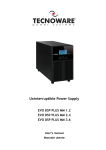
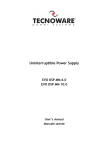
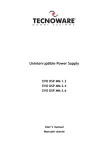
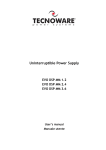
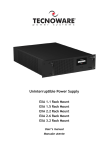
![[ENG-ITA] User's Manual UPS EVO DSP PLUS MM 1.2-2.4](http://vs1.manualzilla.com/store/data/006884869_1-f09fb11d812c485aa10a235685fba597-150x150.png)
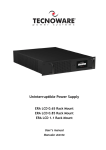
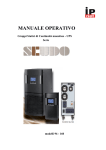
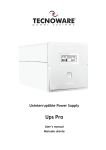
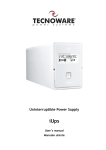
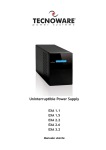
![[ITA] ERA LCD 1.5 - 2.0 - 2.6 v.3.0](http://vs1.manualzilla.com/store/data/006158360_1-723f61f8946d2d729252a86ec11afdef-150x150.png)
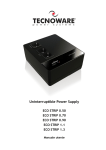
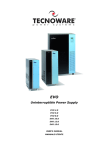
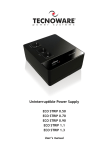
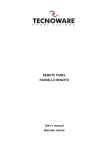
![Evo 6-15 TM USER MANUAL_vers. 4.0_[EPO CHIUSO]](http://vs1.manualzilla.com/store/data/006156965_1-3c2ff8a96ef48085f557a3503c0c4135-150x150.png)
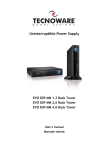
![[ENG] EVO DSP TM 10-30 kVA User Manual v. 2.0](http://vs1.manualzilla.com/store/data/005715238_1-26b73917878f712f842422018d03a475-150x150.png)
